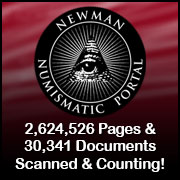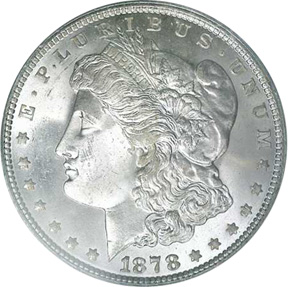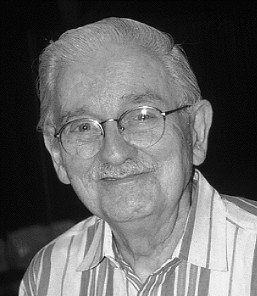
About UsThe Numismatic Bibliomania Society is a non-profit association devoted to the study and enjoyment of numismatic literature. For more information please see our web site at coinbooks.org SubscriptionsThose wishing to become new E-Sylum subscribers (or wishing to Unsubscribe) can go to the following web page link MembershipThere is a membership application available on the web site Membership Application To join, print the application and return it with your check to the address printed on the application. Print/Digital membership is $40 to addresses in the U.S., and $60 elsewhere. A digital-only membership is available for $25. For those without web access, write to: Charles Heck, Treasurer
AsylumFor Asylum mailing address changes and other membership questions, contact Chuck at this email address: treasurer@coinbooks.org SubmissionsTo submit items for publication in The E-Sylum, write to the Editor at this address: whomren@gmail.com BUY THE BOOK BEFORE THE COIN |
- WAYNE'S WORDS: THE E-SYLUM SEPTEMBER 29, 2019
- KOLBE & FANNING SALE 154 ANNOUNCED
- ROYAL NUMISMATIC SOCIETY PUBLICATION SALE
- NEW BOOK: GOLD COINS FROM SWEDEN, 1512-2020
- NEW BOOK: MEDAL YEARBOOK 2020
- BANKNOTE BOOK GUATEMALA CHAPTER PUBLISHED
- NEW BOOK: ATLAS COLLECTION OF GREEK BANKNOTES
- NEW BOOK: COINS OF ENGLAND COLOURING BOOK
- SCOUTS COIN COLLECTING MERIT BADGE VIDEO
- FUTURE OF NUMISMATICS: KARSTEDT
- INSPIRATIONS FOR THE MORGAN DOLLAR DESIGN
- MORE ON OCTAGONAL LARGE CENTS
- COPPERHEAD TOKENS OF THE CIVIL WAR
- NOTES FROM E-SYLUM READERS: SEPTEMBER 29, 2019
- VOCABULARY TERM: FACE MILLED
- NELSON THORE THORSON (1881-1951)
- SHERBROOKE SEMINARY SALE SELECTIONS
- NUMISMATIC NUGGETS: SEPTEMBER 29, 2019
- ANGLO-SAXON COIN HOARD FOUND IN SUFFOLK
- MINE OF THE COMMANDER OF THE FAITHFUL
- LOUIS VIII OF HESSE-DARMSTADT HUNTING MEDALS
- MOST VALUABLE TREASURE TROVES EVER FOUND
- THE QUEEN'S STAMP COLLECTION
- LOOSE CHANGE: SEPTEMBER 29, 2019
- FEATURED WEB PAGE: JEWISH UKRAINE NUMISMATICS
Click here to access the complete archive a
Click here to unsubscribe (scroll down)
To comment or submit articles, reply to whomren@gmail.com
Content presented in The E-Sylum is not necessarily researched or independently fact-checked, and views expressed do not necessarily represent those of the Numismatic Bibliomania Society.
WAYNE'S WORDS: THE E-SYLUM SEPTEMBER 29, 2019
 New subscribers this week include: Scott English, Executive Director of the American Philatelic Society, and Tracy Schmidt, Editor at Active Interest Media. Welcome
aboard! We now have 6,003 subscribers.
New subscribers this week include: Scott English, Executive Director of the American Philatelic Society, and Tracy Schmidt, Editor at Active Interest Media. Welcome
aboard! We now have 6,003 subscribers.
Thank you for reading The E-Sylum. If you enjoy it, please send me the email addresses of friends you think may enjoy it as well and I'll send them a subscription (but let me know if they are located in the European Union). Contact me at whomren@gmail.com anytime regarding your subscription, or questions, comments or suggestions about our content.
This week we open with a new sale from numimatic booksellers Kolbe & Fanning, five new books, two videos and inspirations for the Morgan dollar design.
Other topics this week include eight-sided Large Cents, copperhead tokens of the Civil War, ANA President Nelson Thorson, the Sherbrooke Seminar sale, an Anglo-Saxon coin hoard, hunting medals, and the most valuable treasure troves ever found.
To learn more about the gold coins of Sweden, Greek and Guatemalan banknotes, $2 bill payroll stunts, the Civil Rights "money mark", the 1770 Royal Academy Prize medal, the 1872 Dominion of Canada Chiefs medal, the Circus Saints and Sinners medal, secesh emblems and the Queen's stamp collection, read on. Have a great week, everyone!
Wayne Homren
Editor, The E-Sylum
KOLBE & FANNING SALE 154 ANNOUNCED
Kolbe & Fanning's next numismatic literature sale featuring the library of George F. Kolbe will close October 26, 2019. Here's the announcement. -Editor
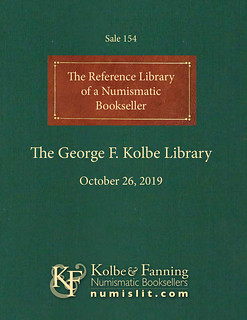 Kolbe & Fanning will be offering for sale at auction the personal library formed by numismatic bookseller George F. Kolbe on Saturday, October 26, 2019. The 166-page
auction catalogue will mail in about one week to clients currently on our mailing list. A PDF of the printed catalogue is available now on the main Kolbe & Fanning website at
numislit.com, and the live internet auction can be accessed via our online auction platform at bid.numislit.com.
Kolbe & Fanning will be offering for sale at auction the personal library formed by numismatic bookseller George F. Kolbe on Saturday, October 26, 2019. The 166-page
auction catalogue will mail in about one week to clients currently on our mailing list. A PDF of the printed catalogue is available now on the main Kolbe & Fanning website at
numislit.com, and the live internet auction can be accessed via our online auction platform at bid.numislit.com.
The Kolbe Library was catalogued by George himself in his 2012 book, The Reference Library of a Numismatic Bookseller (now out of print). The auction features not only those works discussed in that volume, but additional items acquired in the years since. It is an outstanding offering of numismatic bibliographies, reference books, catalogues, and special editions from around the world amassed over a career spanning more than half a century.
A few selected highlights include:
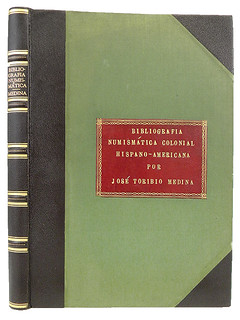
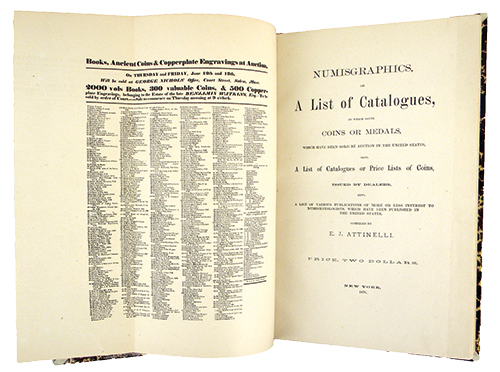
Lot 96: Milford Haven's copy of Medina's rare 1912 Bibliografia Numismática Colonial Hispano-Americana
Lot 133: a fine first edition copy of Emmanuel J. Attinelli's 1876 Numisgraphics
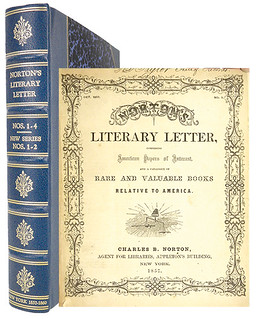
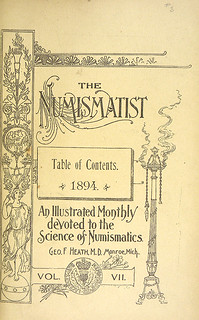
Lot 151: a complete bound set of Norton's Literary Letter, including the first article about the history of numismatic literature in America
Lot 260: a complete bound set of The Numismatist
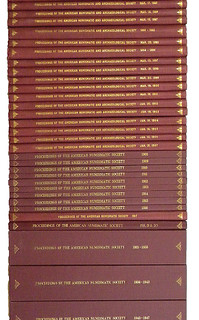
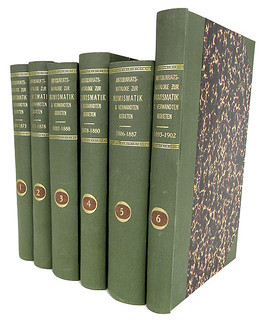
Lot 262: an exceptional, complete bound set of the ANS Proceedings volumes, a rare and under appreciated source of information
Lot 323: six bound volumes of over 90 antiquarian bookseller catalogues offering numismatic literature, from the library of Emil Bahrfeldt
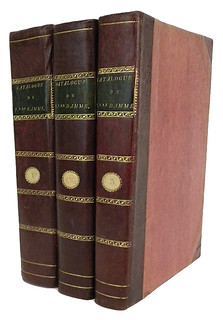
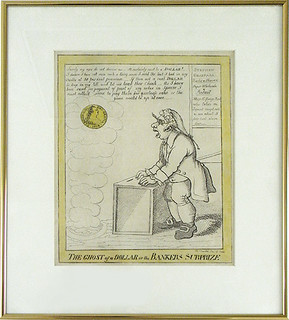
Lot 329: an outstanding complete set of the 1808 auction catalogues of the Pieter Van Damme coin collection and library, printed on special paper, in contemporary bindings, and entirely priced and named
Lot 443: William Charles's famous caricature (c. 1815) of Philadelphia merchant banker Stephen Girard, The Ghost of a Dollar
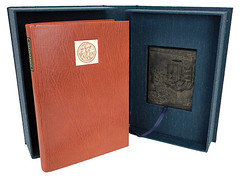
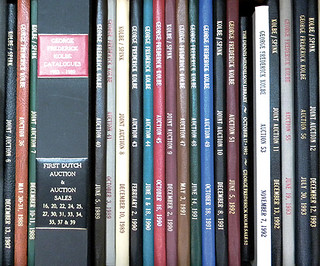
Lot 467: a deluxe edition of Bird & Bull Press's leaf book of Alciato's Emblemata, with an original wood engraving used to print one of the woodcuts commissioned for this work
Lot 482: George Kolbe's complete hardcover set of his own catalogues, including extremely rare individual bindings and other delicacies.
Bids may be placed via post, email, fax or phone, as well as online. Kolbe & Fanning use Auction Mobility as our third-party online bidding platform. To register for the sale, bidders should go to bid.numislit.com and sign up. Once you have set up an account, you may browse lots, place advance bids, or participate in the live sale on your computer, tablet, or phone. Those wishing to participate on their devices can download the Kolbe & Fanning app through the Apple or Google Play Store.
Bids placed via post, email, fax or phone must be received by October 25, the day before the sale, in order for them to be processed. Advance absentee bids may also be placed at any time online at bid.numislit.com; live internet bidding will be available during the sale itself through the same platform.
Kolbe & Fanning Numismatic Booksellers LLC is a licensed and bonded auction firm in the State of Ohio. For more information, please see the Kolbe & Fanning website at numislit.com or email David Fanning at df@numislit.com. To register for the sale, go to bid.numislit.com. To sign up to receive Kolbe & Fanning's occasional email announcements, please visit numislit.com or email Maria Fanning at maria@numislit.com. We look forward to your participation.

ROYAL NUMISMATIC SOCIETY PUBLICATION SALE
SPINK is running a sale on Royal Numismatic Society publications. Here are some sample titles. -Editor
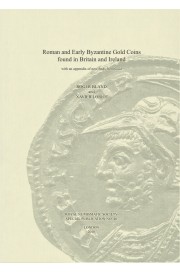
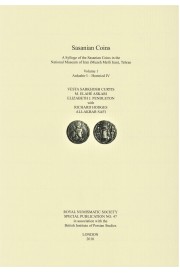
Roman and Early Byzantine Gold Coins found in Britain and Ireland with an Appendix of new Finds from Gaul by Roger Bland and Xavier Loriot.
Sylloge of the Sasanian Coins in the National Museum of Iran: Volumes 1 and 2
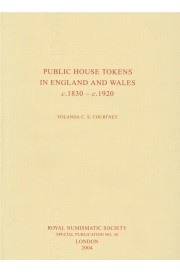
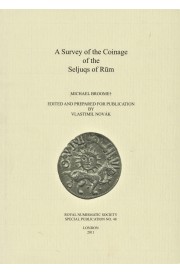
Public House Tokens in England and Wales c.1830-c.1920 by Courtney,
A Survey of the Coinage of the Seljuqs of Rum by Broome
For more information, or to order, see:
RNS Special Offers (https://spinkbooks.com/index.php?route=product/category&path=105)
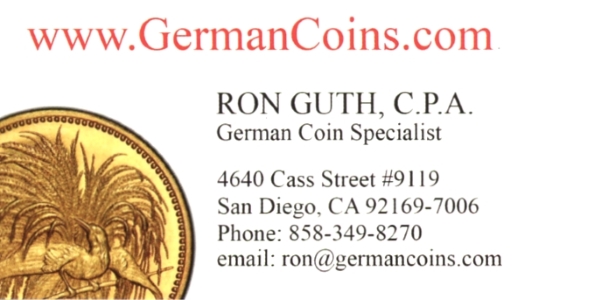
NEW BOOK: GOLD COINS FROM SWEDEN, 1512-2020
A new book on the gold coins of Sweden has been published. Here's the press release from the Coin & Currency Institute. -Editor
New Book on the Gold Coins of Sweden is First Work on the Subject in Nearly 40 Years
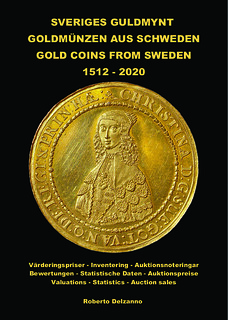 Not since the publication of The Coinage of Sweden, in 1977, and Coins of the Swedish Possessions in 1980, has there been any concerted effort to update
the extensive and diverse gold coin issues of this widely collected area of numismatics.
Not since the publication of The Coinage of Sweden, in 1977, and Coins of the Swedish Possessions in 1980, has there been any concerted effort to update
the extensive and diverse gold coin issues of this widely collected area of numismatics.
With the Fall 2019 publication of Sveriges Guldmynt, 1512-2020 - Värderingskatalog med inventering och statistik (Gold Coins From Sweden,1512-2020 - Catalog with valuations, statistics, and auction sales) by Roberto Delzanno, a Swedish professional numsmatist since the 1980's, that has all changed.
The just-published, 450 page, large format (A4), hard-bound, full-color volume expands mightily on its predecessors. It is in three languages – Swedish, with German and English translations where approporiate and includes: All the gold coins of Sweden from 1512 to 2019 listed by date; the gold coins of the Swedish possessions from 1561 to 1878; the coinage struck by Fredrick I, Landgrave of Hesse-Kassel as King of Sweden, 1730-1751; and selections of royal medals and personal medals from 1512 to date.
Prices in Swedish kroner (1 kroner = U.S. 10 cents) are given for most coins in three conditions, usually very fine, extremely fine, and extremely fine/uncirculated (Swedish grades 1+, 01, and 01/0). In addition to a price, each coin is given a rating on a rarity scale and is cross-referenced to catalog numbers from Friedberg, Gold Coin of the World, and Svenska Mynt. Results from auction sales are included for nearly every coin for which there are records.
Other features include in-depth articles on selected coins and medals, a presentation of a selection of medal engravers, and detailed enlargements of many coins with explanatory text. There is also coverage of mint masters, coin engravers, mint locations, and short, often entertaining histories.
Gold Coins From Sweden,1512-2020 (ISBN: 978-91-639-9466-1) will be available in late October. In North America, order from Coin & Currency Institute, P.O. Box 399, Williston, VT 05495 for $54.95 plus $5.75 for postage and handling or on www.coin-currency.com by clicking on the image of the book's cover. Major credit cards are accepted. Call toll-free 1-800-421-1866, fax (802) 536-4787 or e-mail: mail@coin-currency.com .
Sample pages from it and more information may be found at www.coin-currency.com or https://delzanno.se/. The book is also widely available from coin and numismatic book dealers in Europe.

NEW BOOK: MEDAL YEARBOOK 2020
Token Publishing has produced a new edition of their medal yearbook. -Editor
 The new MEDAL YEARBOOK 2020 is NOW AVAILABLE! Launched at the OMRS Convention in Nottingham on Sunday, September 15. Once again the acclaimed MEDAL YEARBOOK comes in two
very distinct formats – the standard softback YEARBOOK remains as it always has, as an indispensable guide to British and Empire Medals, every official (and some unofficial!)
medal awarded to the uniformed services (military and non-military) of Britain and the Empire with all medals and their ribbons illustrated in colour.
The new MEDAL YEARBOOK 2020 is NOW AVAILABLE! Launched at the OMRS Convention in Nottingham on Sunday, September 15. Once again the acclaimed MEDAL YEARBOOK comes in two
very distinct formats – the standard softback YEARBOOK remains as it always has, as an indispensable guide to British and Empire Medals, every official (and some unofficial!)
medal awarded to the uniformed services (military and non-military) of Britain and the Empire with all medals and their ribbons illustrated in colour.
It also features full descriptions of the medal and explanations of what the medal was awarded for and why, as well, of course, as having all the prices updated to give the best idea possible of “what it's worth”, whether you are trying to value a single medal, a family group or an entire collection. As well as the softback yearbook, there is, once again, a special DELUXE Hardback version featuring everything that is in the standard edition and also the welcome return of the current COMMONWEALTH medals, orders and decorations of AUSTRALIA, CANADA, NEW ZEALAND & SOUTH AFRICA. Both editions continue to feature handy hints and tips for the collector as well as the CUMULATIVE INDEX to the YEARBOOK's parent magazine MEDAL NEWS!
For more information, or to order, see:
Medal Yearbook 2020 standard edition (https://www.tokenpublishing.com/shop/product/8024/16)

BANKNOTE BOOK GUATEMALA CHAPTER PUBLISHED
Owen Linzmayer publishes The Banknote Book, a useful, constantly updated electronic reference. On September 27, 2019 he announced via email the availability of the chapter on the banknotes of Guatemala. It's available for $9.99. -Editor
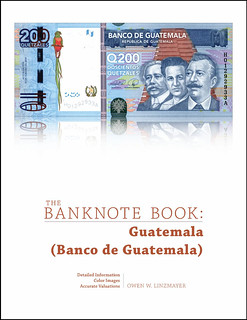 We're very pleased to announce that the Guatemala chapter is now available for individual sale and as a free download to subscribers. Coverage of the earlier issues
will be added to the chapter once research is complete. Thanks to all the contributors who have helped provide information and images. Keep that input coming!
We're very pleased to announce that the Guatemala chapter is now available for individual sale and as a free download to subscribers. Coverage of the earlier issues
will be added to the chapter once research is complete. Thanks to all the contributors who have helped provide information and images. Keep that input coming!
Guatemala (Central America)
This 46-page catalog covers notes issued by the Banco de Guatemala (Bank of Guatemala) from 1946 to present. Published 27.09.2019.
For more information on The Banknote Book, see:
http://www.banknotenews.com/banknote_book/
banknote_book.php
NEW BOOK: ATLAS COLLECTION OF GREEK BANKNOTES
A new book on Greek banknotes has been published. Found via the September 17, 2019 issue of News & Notes from the Society of Paper Money Collectors. -Editor
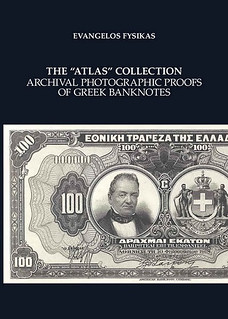 Since the mid-1980s, most of the large archive of the American Bank Note Company (ABNC) and Bradbury, Wilkinson & Co. (BWC) had gradually began to be auctioned. In
this way, collectors were able to obtain a huge number of items related to the creation and printing of banknotes of these two companies. Within this wealth of objects, there were
also some books on whose pages there were attached many black and white photos of proof banknotes at various stages of their preparation. These were collages of drawings and
various individual printed parts such as vigniettes, geometric patterns, signatures or serial numbers.
Since the mid-1980s, most of the large archive of the American Bank Note Company (ABNC) and Bradbury, Wilkinson & Co. (BWC) had gradually began to be auctioned. In
this way, collectors were able to obtain a huge number of items related to the creation and printing of banknotes of these two companies. Within this wealth of objects, there were
also some books on whose pages there were attached many black and white photos of proof banknotes at various stages of their preparation. These were collages of drawings and
various individual printed parts such as vigniettes, geometric patterns, signatures or serial numbers.
The photographic proofs and the accompanying notes gave us a lot of information about the alternative forms that our banknotes could have, and that they filled many gaps in our "banknote" history. It is believed that these photographic proofs are the only surviving copies of the kind currently available in the collector market.
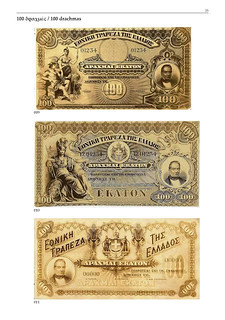
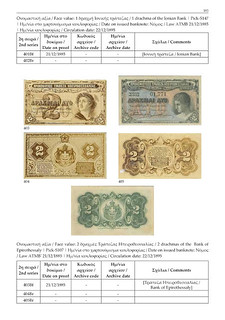
The present work is divided into two main parts. First, it is described how the banknotes were being made 100-150 years ago, and in the second follows the presentation of the photographic proofs divided into sections according to the issuing authority.
The catalogue is a paperback edition, printed in full color. It consists of 208 pages and it is bilingual (Greek & English).
For more information, or to order, see:
Greek Banknotes - Ελληνικά Χαρτονομίσματα (http://greeknotes.blogspot.com/)
The ATLAS Collection Archival Photographic Proofs Of Greek Banknotes
(https://www.karamitsos.com/item.php?type=book&id=EsT5EulbPo27r5ywoU3wrkTIISObkqUY)
THE BOOK BAZARRE
NEW BOOK: COINS OF ENGLAND COLOURING BOOK
SPINK has published a new book - a coloring book of the coins of England & the U.K. -Editor
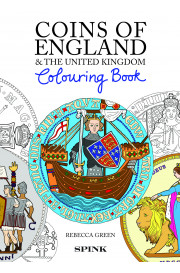 Coins of England & The United Kingdom Colouring Book
Coins of England & The United Kingdom Colouring Book
Paperback, ISBN: 978-1912667-406
From the Celts to the Tudors, the Georgians to our Queen - coins from all around the United Kingdom show many wonderful designs. With 22 full-page illustrations to colour in, each accompanied by a short contextual history this book will provide hours of fun for coin enthusiasts of all ages.
David Pickup writes:
Presumably the colours are copper silver and gold
So why NOT have a coin coloring book? Great idea! Maybe a publisher in the U.S. could test out this concept. Adult coloring books are all the rage these days - why not one for coin collectors? I'll need something to pass the time sitting in my rocker on the front porch of the Old Numismatists home. -Editor
For more information, or to order, see:
Coins of England & The United Kingdom Colouring Book
(http://www.spinkbooks.com/index.php?route=product/product&product_id=693)
SCOUTS COIN COLLECTING MERIT BADGE VIDEO
The latest addition to the Newman Numismatic Portal is a new video about the Boy Scouts coin collecting merit badge. Project Coordinator Len Augsburger provided the following report. -Editor
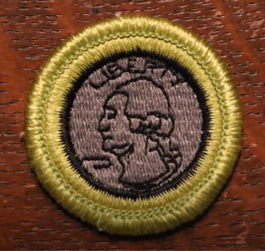 Recently added to Newman Portal is a video from Lianna Spurrier aimed at Scouts BSA members looking to acquire the coin collecting merit badge. There are ten
requirements in the current manual (which George Cuhaj informs us is being reworked) covering numismatic basics, with a emphasis on U.S. issues.
Recently added to Newman Portal is a video from Lianna Spurrier aimed at Scouts BSA members looking to acquire the coin collecting merit badge. There are ten
requirements in the current manual (which George Cuhaj informs us is being reworked) covering numismatic basics, with a emphasis on U.S. issues.
The BSA merit badge doesn't aim to turn kids into large cent attribution experts but rather provides a beginning exposure to the hobby and hopefully delivers a few tools to help more interested members move along further as enthusiasm warrants.
Link to BSA coin collecting merit badge on Newman Portal:
https://nnp.wustl.edu/library/book/569518
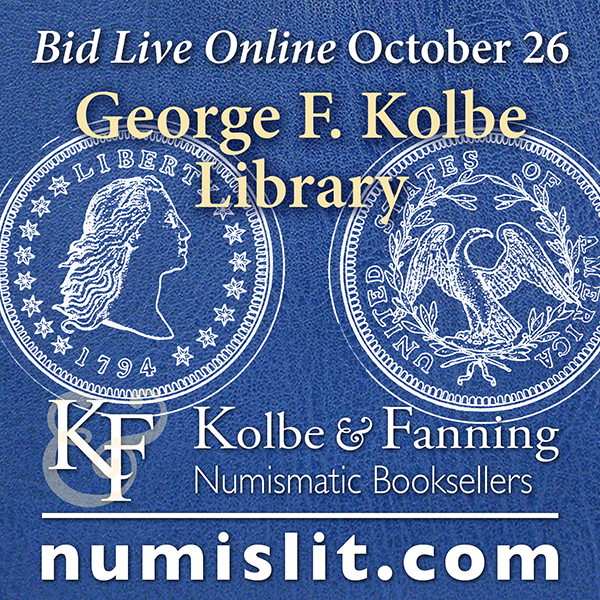
FUTURE OF NUMISMATICS: KARSTEDT
These are selections from the David Lisot Video Library that feature news and personalities from the world of coin collecting. David has been attending coin conventions since
1972 and began videotaping in 1985. The Newman Numismatic Portal now lists all David's videos on their website at:
https://nnp.wustl.edu/library/multimediadetail/522852
Here's one from the ANA Future of Numismatics Symposium. -Editor
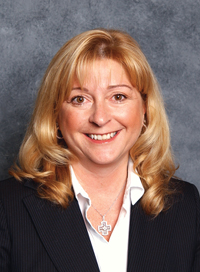 Future of Numismatics Symposium: Christine Karstedt
Future of Numismatics Symposium: Christine Karstedt
An excerpt of the video is available for viewing on the Coin Television YouTube Channel at:
https://youtu.be/XICTxLS1P6k
This video is a highlight from Future of Numismatics Symposium: What the Future May Hold
Donn Pearlman, Moderator, David Lisot, Video Producer, CoinTelevision.com.
At the 2019 World's Fair of Money the American Numismatic Association asked some of the coin industry's most influential leaders about what they believe is in store for the future of the hobby. Hear these titans of numismatics share what they believe the future holds.
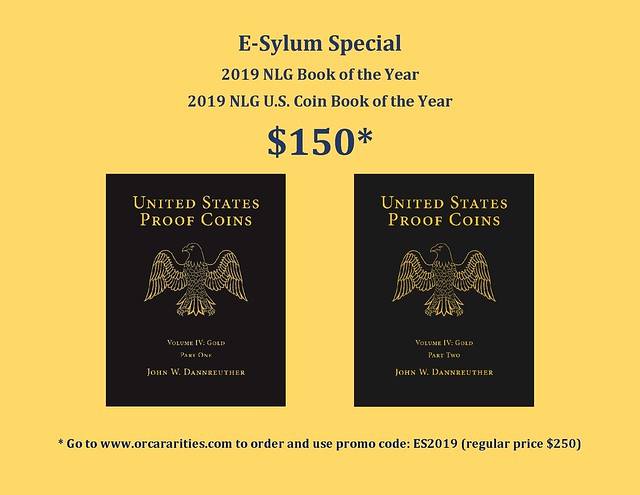
INSPIRATIONS FOR THE MORGAN DOLLAR DESIGN
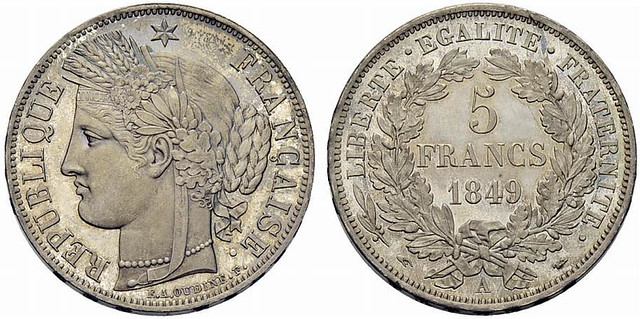
I collect French coins and I found the article “The Girl On The Silver Dollar” interesting. Many years ago I bought an 1850 French “Ceres Head” 5 Francs in a Stack's/Coin Galleries auction. It was the first French coin in that collection...I loved the design and it got me started collecting French coinage. There are stories that the “Ceres Design” inspired George Morgan in his design for the silver dollar....who knows?
Well, on p12 of Roger Burdette's new book, he discusses Morgan's design influences. With permission we're republishing that section here. -Editor
"His training was, like so many artists of the day, grounded in copying classical models with a strong emphasis on French interpretation. The half dollar's Liberty of 1876 could have easily been based on dozens of classical and French examples, such as the pattern 5 franc obverse of 1851 shown below, left."
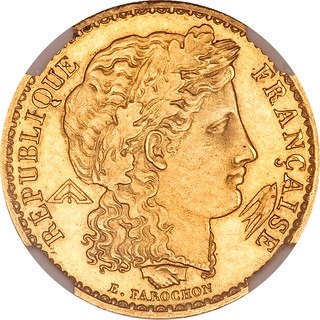
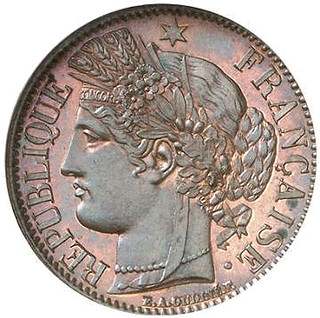
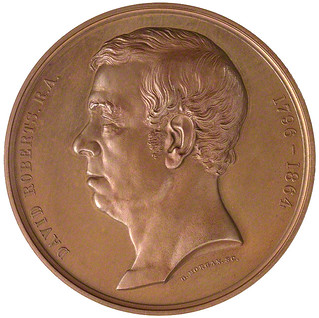
"Figure 2. Sample of French coin designs by Jean-Baptiste Eugène Farochon (1848, left) and Eugène André Oudiné (1868, center) typical of the style learned by Morgan and brought to his earliest American coin and medal work."
The design influences are clearly there, but artists generally use that history as a starting point and branch off from there. Often multiple images, designs and models will influence each new work in both obvious and subtle ways. -Editor
To read the earlier E-Sylum article, see:
NEW BOOK: GIRL ON THE SILVER DOLLAR (https://www.coinbooks.org/v22/esylum_v22n38a02.html)
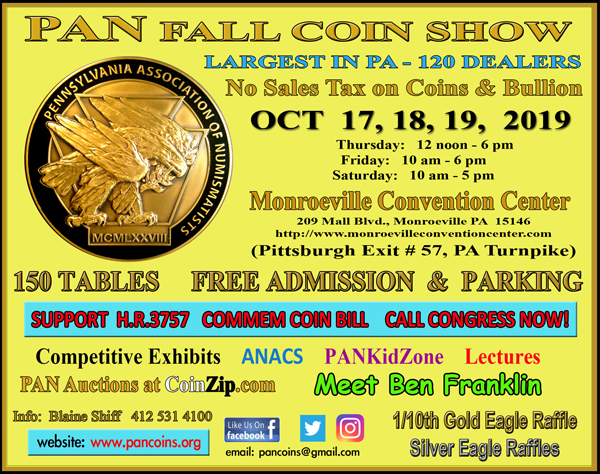
MORE ON OCTAGONAL LARGE CENTS
Pete Smith writes: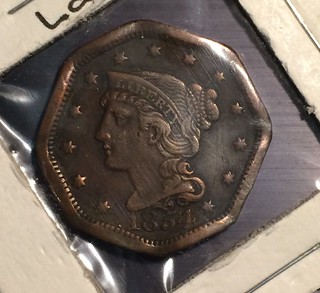 "There are a couple of eight sided large cents shown on the Coin Community site. In my opinion, the 1854 cent shown was originally a round mint-struck cent. The
bulging of the rims indicates that it was hammered into this shape although squeezing in a vice might produce similar results. The modification could have been done in 1855 or
1955. If you want one done in 2019, I can get that for you.
"There are a couple of eight sided large cents shown on the Coin Community site. In my opinion, the 1854 cent shown was originally a round mint-struck cent. The
bulging of the rims indicates that it was hammered into this shape although squeezing in a vice might produce similar results. The modification could have been done in 1855 or
1955. If you want one done in 2019, I can get that for you.
"If one such piece was done for the Underground Railroad, that does not prove that any other piece was done for the same purpose. Without documentation tied to a specific piece, they are just severely damaged cents."
Indeed. Thanks. -Editor
To read the complete Coin Community discussion, see:
1851 Braided Penny Octagon Shape (https://www.coincommunity.com/forum/topic.asp?TOPIC_ID=267273)
Bill Groom writes:
"I've long collected and studied what I call "repurposed coins" - a euphemism for intentionally damaged coins. While counterstamps have been my main focus, other intriguing pieces, like Tony Payne's octagonal large cent never fail to catch my eye and imagination. A few thoughts immediately come to mind ....
"Tens of thousands of counterstamped coins owe their damage to machinists, plying their trade. They made the punches, which often included the manufacture of their own, personal name punch. They were masons who would naturally test and show their skills, their precision work. Lowly copper coins tended to often be subjected to their experimentation.
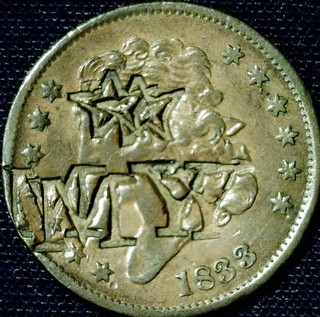 "I've long wondered if any repurposed coppers could have been utilized by members of the underground railroad. I've continually searched early newspapers,
books and periodicals over the years, hoping to find documentation for this possibly contemporary use of coins as such. I've yet to catch a scent. The most intriguing
possibility to me are the MY (star) counterstamps, of which a half dozen or more have been thus far reported; all, on half cents. The latest dated host coin is 1835.
"I've long wondered if any repurposed coppers could have been utilized by members of the underground railroad. I've continually searched early newspapers,
books and periodicals over the years, hoping to find documentation for this possibly contemporary use of coins as such. I've yet to catch a scent. The most intriguing
possibility to me are the MY (star) counterstamps, of which a half dozen or more have been thus far reported; all, on half cents. The latest dated host coin is 1835.
"The only contemporary, documented use of purposely damaged large cents that I've been able to find addresses the cause of Civil War era copperheads. I'm attaching herewith an article on that subject that I penned not too long ago. Might Tony Payne's octagonal coin have been made for a copperhead? If so, was it sarcastically fashioned into the shape of a nut? Interesting thoughts to ponder, these, but only the long gone maker knows for sure!
"Exonumismatically yours, Bill Groom"
Bill's write-up on Copperhead Tokens of the Civil War appears in full in the next article in this issue. -Editor
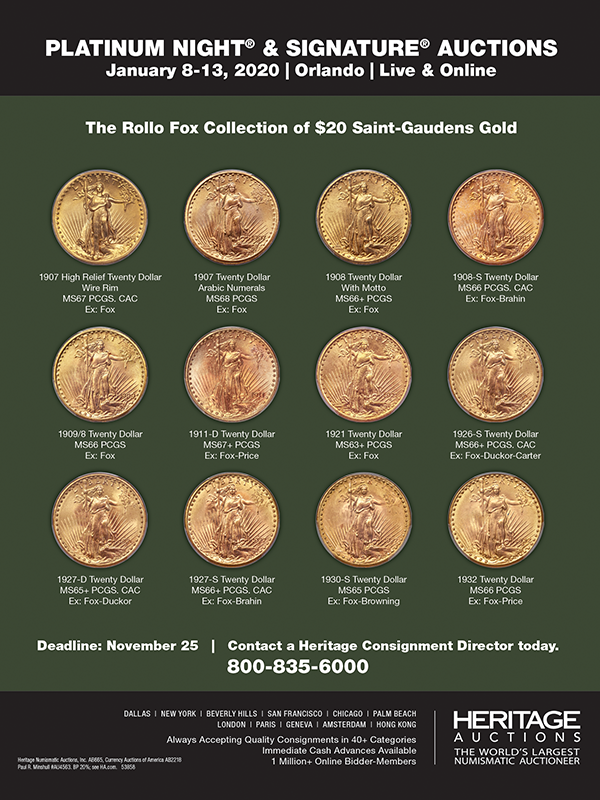
COPPERHEAD TOKENS OF THE CIVIL WAR
Bill Groom submitted this article on Copperhead Tokens of the Civil War. Thanks! -Editor
During the Civil War era, northern Democrats who sought to make peace with the Confederacy, take the “live and let live” position were deemed Copperheads by the Republicans. These more extremist Democrats were likened to the venomous copperhead snakes. The below, patriotic Civil War token (Fuld 136/397a) was an anti-Copperhead piece ...
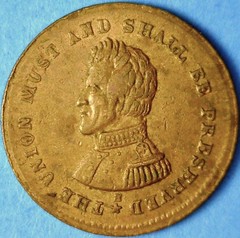
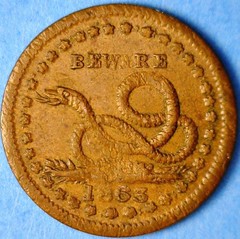
Many of the so-called Copperhead Democrats openly flaunted their political position by adopting and wearing a Copperhead badge. The badge was nothing more than a cut-down, miniaturized large cent. The obverse stars and reverse legend, United States of America, were removed. The obverse Liberty head was displayed, and a pin was typically soldered to the reverse. The Copperheads were a distinct minority and largely reviled. Rather than invite assault, many of them took to carrying this symbolic token as a pocket piece to share with fellow Copperheads. Below are shown a few examples …
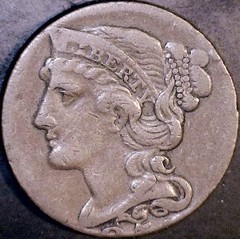
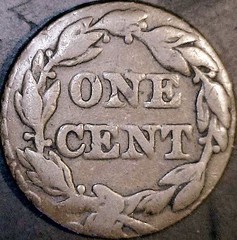
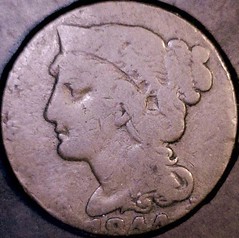
Here's a contemporary newspaper article about the “Copperhead” badge ...
Wednesday, March 18, 1863
The young Democrats of Syracuse have adopted a “Copperhead” badge. It is made by procuring one of the large United States copper cents, and neatly removing the head of the “Goddess of Liberty.” To this is affixed a pin, which fastens to the lapel of the coat, or any other conspicuous place on the wearer where he chooses to display it.
Judging from the below newspaper article, it appears that the Copperhead badges took root in Connecticut. The article ends, saying they “are worn without shame” ...
April 17, 1863
A NEW EMBLEM OF TREASON.
While General Wool and staff, on their recent trip to Connecticut, were awaiting in Bridgeport the arrival of a train, a copperhead; adherent of Seymour showed the symbol of his tribe (a badge) in the presence, of the General.
The copperhead badge is the head of an old copper cent cut out from the body of the coin, and attached to a pin, so that it can be fastened as an emblem on the coat or vest of the wearer. The General regarded the man for a moment, with an expression of scorn upon his face, and said "such men ought not to be at large in our midst — you are a traitor.” The veteran soldier then turned away from the man he had so signally rebuked; but we do not learn that the copperhead exhibited the slightest sensitiveness in regard to his position.
The manufacture of the copperhead emblems we have described is regularly carried on in Connecticut, and they have been adopted by the Seymour party as the token of their principles. Large numbers of them are sold, and they are worn without shame.
An “I told you so” appeared in a Republican newspaper some months later …
COPPERHEAD.
The editor of the Advance don't like to be called a copperhead. It is less than a year since that concern advised its friends to put on the copperhead badge and wear it. Our opinion at that time was that it would be ashamed of itself before the year was ended. On Tuesday the people will bury the whole copperhead fraternity past resurrection.
The wearing of the Copperhead badges seems to have peaked during 1863. General Grant's victory at Vicksburg during the summer of that year turned the tide of the war. The Union cause was bolstered, and the argument of the Copperheads was much diminished. These little copper badges increasingly caused public turmoil, as evidenced by the below newspaper account, following the Vicksburg victory.
COPPERHEADS CLEANED OUT AT MT. VERNON, IOWA
The Muscatine (Iowa) Journal says there was an exciting time at the anniversary exercises of Cornell College, at Mt. Vernon, on the 28th. It seems that about a dozen persons from Marion appeared in the crowd with Copperhead pins. About two thousand persons were present, the exercises being held in a grove. On the appearance of the secesh emblems, business was suspended by the tumult, and every Copperhead badge was hastily taken from its owner and he forced to hurrah for the Union. A gray-headed traitor, who has long been blatant for the Southern Confederacy, declared that he would not hurrah for the Union, but a little choking brought him to terms. One young woman had on the southern badge, which was torn from her breast, clothes and all, by another young woman. The latter bad her bonnet destroyed in capturing the pin, and some young men raised eight or ten dollars in order to replace the bonnet. The Copperhead pins being all "cleaned out," the exercises were resumed, and passed off very satisfactorily.
RETURNED SOIDIERS PUNISH A COPPERHEAD
An exciting affair took place last evening at Shunpike, a small station on the Central road, a short distance west of Auburn. When the train containing the 26th regiment reached there, the station keeper made his appearance wearing a copperhead badge on his coat, in plain sight. This disloyal exhibition incensed the soldiers, and in less time than we are relating the occurrence, the odious emblem was torn off.
The station keeper, allowing his zeal in a bad cause to out-do his discretion, got very mad, and starting for his house, declared that he would get his pistol and shoot his assailants. Upon this some two hundred of the soldiers surrounded the house, smashed in the windows and doors and nearly destroyed the structure. They would have severely handled the misguided copperhead himself, if he had not made haste to escape by a back door. The conductor of the train, upon hearing of the occurrence, hurried up the departure of the train.
The copperheads will learn speedily that the soldiers look upon them as no better than rebels in arms, and woe be to them it they do not keep their unpatriotic feelings within due bounds. — Syracuse Journal
Might the below cents have been whimsically fashioned by Copperheads? No way of telling, but they may well have been. The one on the top is crude, whereas the one on the bottom was skillfully machined in the shape of a nut … a contrarian political statement, perhaps?
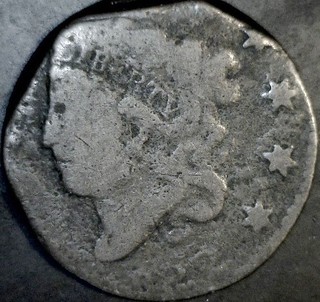
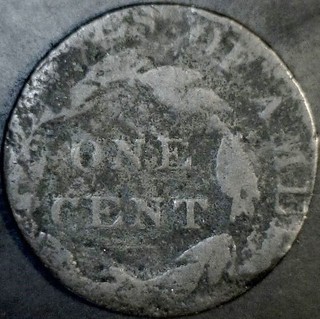
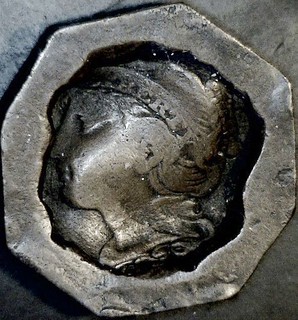
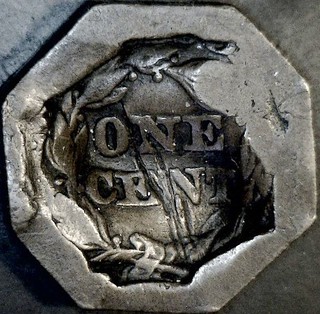
These Copperhead tokens don't command much attention from die-hard collectors of Civil War tokens, yet it's clear that these pieces have no less of a story to tell about that era. Indeed, one of these would fit comfortably within a display of pacifist Civil War tokens, would it not?
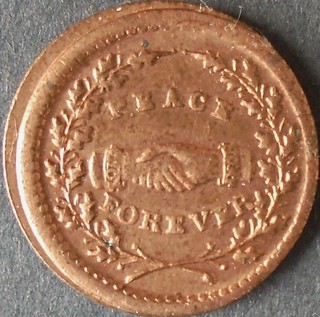
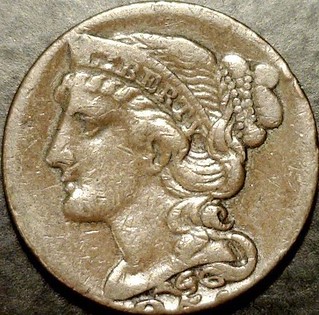
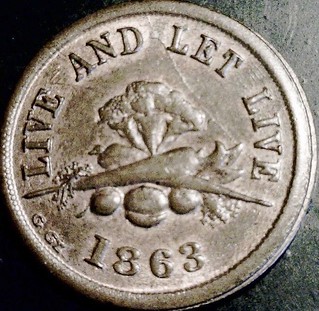
To read the earlier E-Sylum article, see:
QUERY: OCTAGONAL LARGE CENT INFORMATION SOUGHT (https://www.coinbooks.org/v22/esylum_v22n38a09.html)
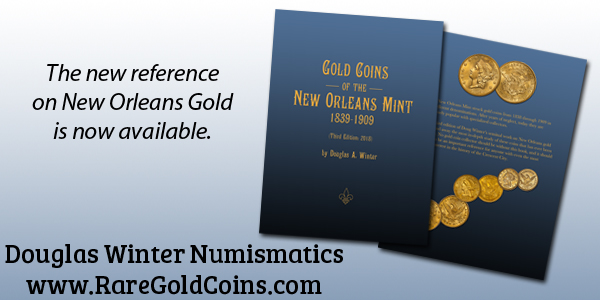
NOTES FROM E-SYLUM READERS: SEPTEMBER 29, 2019
A Reader Endorsement
David Tripp writes:
The E-Sylum is, in my opinion, the most interesting agglomeration of numismatic tidbits, full stop.
Thanks! It's always fun to put together - there's always something interesting to cover. Keep those (virtual) cards and letters coming, folks. -Editor
Another Noe-1 Pine Tree Shilling
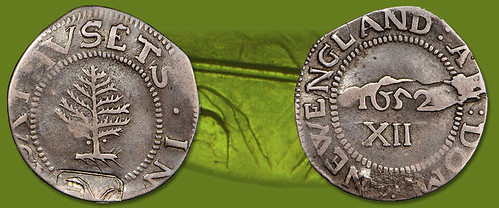
Steve Feller writes:
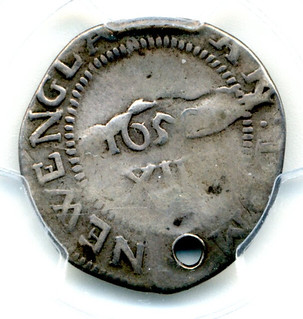 Your piece on the pine tree shilling resonated for me as I have one, holed, in nearly same die state of Noe-1. While my coin is more worn it is clearly the same die.
But the wear is deceptive as much of the appearance is due to the worn and broken die. My coin is likely clipped as well as its weight is just 62.1 grains. Can you
tell which coin is in the later state? Close examination shows that the one you pictured in The E-Sylum is a bit later.
Your piece on the pine tree shilling resonated for me as I have one, holed, in nearly same die state of Noe-1. While my coin is more worn it is clearly the same die.
But the wear is deceptive as much of the appearance is due to the worn and broken die. My coin is likely clipped as well as its weight is just 62.1 grains. Can you
tell which coin is in the later state? Close examination shows that the one you pictured in The E-Sylum is a bit later.
While in Boston recently I visited the joint grave of John Hull the mintmaster who produced the pine tree shillings. I refer you to the great short story "The Pine Tree Shilling" by Nathaniel Hawthorne. I love the charm of the pine tree shilling and this one in particular.
Thanks. Nice coin! -Editor
To read the earlier E-Sylum article, see:
THE INFAMOUS "NE" PINE TREE SHILLING (https://www.coinbooks.org/v22/esylum_v22n38a22.html)
$2 Bills As a Statement of Economic Power
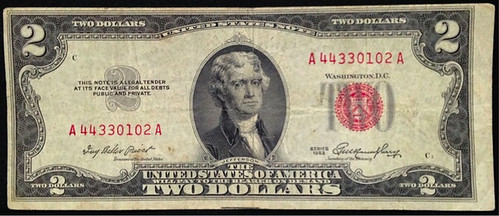
Cynthia Smith writes:
The item about the $2 bill brought to mind my late husband's story that while stationed at the Aberdeen Proving Ground in the late 1950's, all the post GI's one month received their pay in $2 bills. The reason? to show the town of Aberdeen, Maryland the positive impact of the GI's on the town's economy as they spent their pay, to counter any negatives they apparently brought on the town! Money talks!
Thanks. In a similar vein, I've read about businesses who paid their entire workforce in silver dollars for similar publicity reasons. Uncle Sam may have done the $2 bill stunt elsewhere. Here are a couple related items I found online. -Editor
Military Pay in $2 Bills
I was looking through my dad's coin and currency collection with my mom. He had saved several $2 bills (consecutive years) from the mid 1950's.
My mom said it was from his military pay. The local town was bitching about the airmen in their midst. To make a point, the base started paying the men in $2 bills. Within days that whole town was covered up in two dollar bills. Every merchant had them in their cash register. Very obvious, because cash drawers don't have a slot for $2 bills. They must have done it for several years because dad had save a bill from each year. It was a reminder of what the base did for the local economy.
This was probably at Eaker Air Force Base (Blytheville, AR) when I was a baby. Or maybe NAS Pensacola when they were dating and first married.
Civil Rights Money Mark
During the early days of the Civil Rights battle, I remember one city telling its black folks to make a specific mark on every bill that went through their hands. Pretty soon,
every bill had that mark.
Interesting stories, particularly the one about the Civil Rights "money mark". But are they true? Can anyone locate contemporary newspaper accounts? -Editor
To read the complete discussion, see:
Is this story about the military paying in $2 bills true?
(https://boards.straightdope.com/sdmb/showthread.php?t=728337)
To read the earlier E-Sylum article, see:
CALL HIM THE $2 BILL GUY (https://www.coinbooks.org/v22/esylum_v22n36a27.html)
NOTES FROM E-SYLUM READERS: SEPTEMBER 22, 2019 (https://www.coinbooks.org/v22/esylum_v22n38a10.html)
More on Arlie Slabaugh
Last week the Chicago Coin Club has announced the tenth inductee into its Hall of Fame - Arlie Slabaugh. Here are reader reactions to the press release. -Editor
Your article brought back many memories of this fine gentleman. He carried a pad of paper with him so one could communicate more easily with him. I remember meeting him on a street in London England many years ago. Now as a reader of old issues of Numismatic Scrapbook, I have come to recognize and appreciate his numismatic experience and insight.
David T. Alexander writes:
Congratulations on the splendid life of the late Arlie Slabaugh. I knew him from several organizations with which both of us were associated and through Numismatic Scrapbook, of which I was the last executive editor. I understood that he worked as linotypist for Lee Hewitt who recalled that Arlie's mind worked so fast that as he set type, he would become aware of a gap coming up at the end of a column and formulate a short to fill in the space before he came to it.
At the Numismatic Literary Guild, he received the Clemy and went on to present the award to the late Eric P. Newman. As I understand it, Arlie could not hear his own words but proceeded slowly with an eye to his audience. Clemy presenters generally wrote elaborate introductions replete with hints from the recipient's past before the name was revealed. Margo Russell, for example, spun out a lengthy tale until noting "Keene, New Hampshire" to a delighted recipient. "Mr. Redbook" Ken Bressett.
Here, Arlie presented a lengthy introduction expressed entirely in the English of the King James Bible. He noted that the Lord Jesus called as his Apostles "a Fisherman," Saint Peter; a physician, Evangelist Saint Luke; and on and on. He himself had picked "a cobbler," referring to Eric P. Newman's lifetime in shoe manufacture. The audience was astounded and cheered loudly! And, oh yes, Arlie's remarkable speech brought the new NLG Executive Director (me) one of those "I was not at the meeting" denunciations of "a blasphemous parody of Sacred Scripture..." Ah well.
To read the earlier E-Sylum article, see:
CHICAGO HALL OF FAME INDUCTS ARLIE SLABAUGH (https://www.coinbooks.org/v22/esylum_v22n38a15.html)
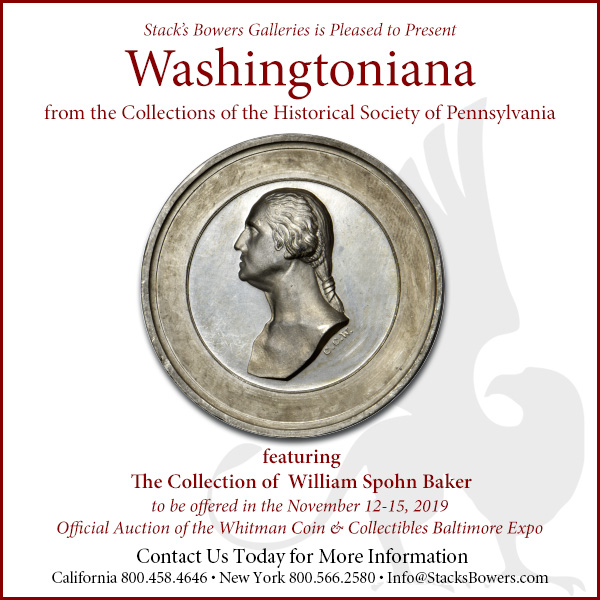
VOCABULARY TERM: FACE MILLED
Dick Johnson submitted this entry from his Encyclopedia of Coin and Medal Terminology. Thanks. -Editor
Face Milled. A smoothed or flattened surface, milled or planed or ground off; said of a medallic or numismatic item in which one or both sides have been smoothed off to be engraved with a new design and/or lettering. Usually it is the reverse which is face milled with the obverse of the coin or medal left intact. All love tokens are so smoothed before they are engraved. It is easiest to remove all relief, including the border, until an absolutely flat surface is obtained across the full flan – it is also possible to face mill both sides, in a sense to make a blank from a struck piece. In rare instances only the relief is ground off one side leaving the raised border intact. Face milling is also done for some hand punched items, very infrequently for counterstamping.
Faceted. With many faces, said of a surface with numerous planes to be reflective and in imitation of a multifaceted jewel. Decorations are sometimes designed with faceted arms or rays, these are lower classes in imitation of higher classes which are indeed inlaid with jewels. Such faceting is sometimes called cut silver.
CLASS 02.33025-(005)08.1
Looking for the meaning of a numismatic word, or the description of a term? Try the Newman Numismatic Portal's Numismatic Dictionary at: https://nnp.wustl.edu/library/dictionary
Or if you would like a printed copy of the complete Encyclopedia, it is available. There are 1,854 terms, on 678 pages, in The Encyclopedia of Coin and Medal Technology. Even running two a week would require more than 19 years to publish them all. If you would like an advance draft of this vital reference work it may be obtained from the author for your check of $50 sent postpaid. Dick Johnson, 139 Thompson Drive, Torrington, CT 06790.
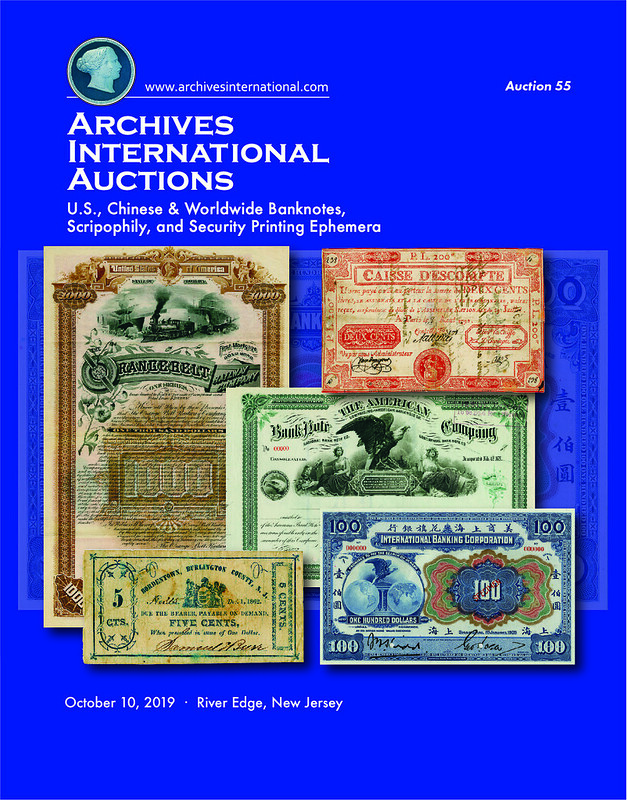
NELSON THORE THORSON (1881-1951)
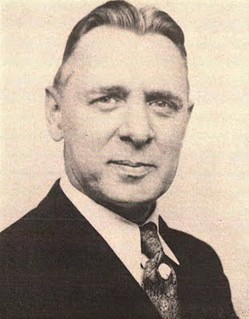 Nelson Thore Thorson (1881-1951), was born on September 16, 1881, at Horby, Sweden, son of John Nels Thorson, a cook, and Hannah Thorson. He originally spelled his
middle name Thore, but later on dropped the "e" sometime in the 1920's. He was a stamp, coin, and paper money dealer who specialized in Scandinavian coins,
Confederate paper money, and medals. He was Life member No. 12 of the ANA, a member of the ANS, Chicago Coin Club, and the New York Numismatic Club. He also collected a wide
variety of curios including : Indian relics, firearms, autographs and jewelry.
Nelson Thore Thorson (1881-1951), was born on September 16, 1881, at Horby, Sweden, son of John Nels Thorson, a cook, and Hannah Thorson. He originally spelled his
middle name Thore, but later on dropped the "e" sometime in the 1920's. He was a stamp, coin, and paper money dealer who specialized in Scandinavian coins,
Confederate paper money, and medals. He was Life member No. 12 of the ANA, a member of the ANS, Chicago Coin Club, and the New York Numismatic Club. He also collected a wide
variety of curios including : Indian relics, firearms, autographs and jewelry.
In 1887, he came to America and became part of the Swedish immigration to Nebraska where Swedes began inhabiting post Civil War. That same year appear the first issue of Omaha svenska tribun, one of the early Swedish-American newspapers in Nebraska.
In 1904, he joined in with 150 Swedes forming the Omaha Posten Publishing Company that issued Omaha Posten, a weekly newspaper for the Swedish-American Nebraskan.
In 1910, Thorson bought the Omaha Posten Publishing Company which he ran until October 1942 selling out to retire into coin dealing. The paper ran until 1954.
He joined the ANA in 1907 and is member no. 888. He collected Scandinavian coins, medals and paper money.
On August 5, 1923, he married Corrine Paulson (1881-1973), a pianist.
From 1926 to 1930, he served as the National Treasurer for the John Ericsson Republican League of America.
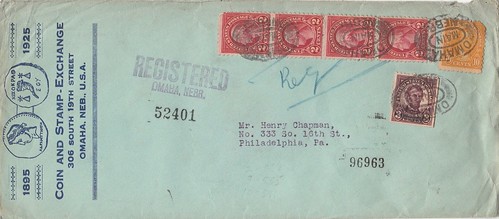
Thorson correspondence with Henry Chapman, Jr., postmarked June 26, 1926
In 1928, he served as a delegate in the Republican National Convention.
From 1929 - 1933, he served as Chairman of the Board, ANA.
From 1933-1935 he served as the 19th president of the ANA.
On Sunday May 6, 1934, he founded the Omaha Coin Club at his home inviting numismatic friends.
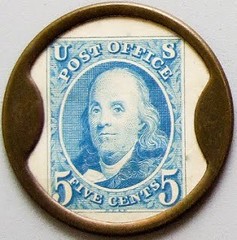
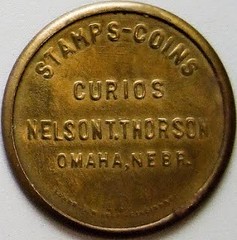
At the 1934 ANA Convention he distributed 200 store cards.
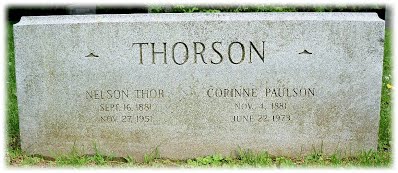 In October 1943, he became a full-time coin dealer.
In October 1943, he became a full-time coin dealer.
He died on November 27, 1951.
To read the complete article, see:
THORSON, NELSON THORE
(https://sites.google.com/a/numismaticmall.com/www/numismaticmall-com/thorson-nelson-thore)
The entire inventory of the Lupia Numismatic Library is for sale. Individual items will be available before the remaining archives are broken up into parcels sold at philatelic auctions in the U. S. and Hong Kong. Check NumismaticMall.com frequently as dozens of new items with estimates will be posted daily until everything is sold.
All inquiries will be given prompt and courteous attention. Write to: john@numismaticmall.com .
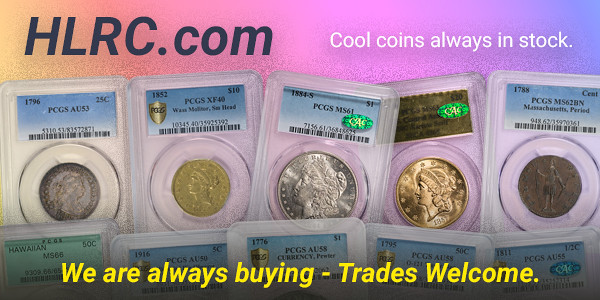
SHERBROOKE SEMINARY SALE SELECTIONS
I stumbled across some great numismatic items earlier this week and began planning to compile an article for this issue. Then on Thursday I saw an article about them by Jesse Robitaille in Canadian Coin News. Here's an excerpt followed by a few highlights of the Champagne Auctions sale. -Editor
Assembled by the Séminaire de Sherbrooke over more than a century and described by auctioneers as an “extraordinary collection,” more than 600 lots of rare material are set to cross the block this September.
Hosted by Montréal's Champagne Auctions, it's the first of four offerings from the expansive collection put together by the long-running seminary's abbots.
“I've been in this business for a while – I'm no youngster – and I've never seen anything like this,” said auction cataloguer Ron Seigler, of MTM International, another Montréal-based firm affiliated with Champagne Auctions.
Located at 195 Marquette St., the Séminaire de Sherbrooke dates back nearly 150 years, to 1874, when Monseigneur Antoine Racine was appointed as the first bishop of the new Diocese of Sherbrooke.
A year later, under Racine's leadership, the Séminaire Saint-Charles-Borromée opened. He served as the first superior until 1878, around which time the seminary's abbots began assembling a collection.
“The seminary's first abbot was in charge and pretty well got to do what he wanted,” said Seigler, who added this interest in numismatics “passed down through the various abbots of the seminary through modern times.”
“The collection kept building over a century, and none of it was sold until now. It's all what we might call 'virgin material' – it's never been offered before.”
The two-session sale to be held Sept. 28-29 is highlighted by seldom-seen “Indian Chief” medals plus a range of British war medals.
Among the top highlights is an 1872 Dominion of Canada “Chiefs Medal” offered as Lot 12.
It's one of only 25 pieces commissioned to be produced by Robert Hendry, a Montréal silversmith, to replace the “inferior stock medals originally presented to the chiefs of Treaties I (Anishinaabeg) and II (Muskego),” auctioneers said.
To read the complete article, see:
'Never-before-seen' Sherbrooke seminary rarities to be auctioned
(https://canadiancoinnews.com/never-before-seen-sherbrooke-seminary-rarities-to-be-auctioned/)
Lot 11: 1814 George III Large Silver Peace Medal
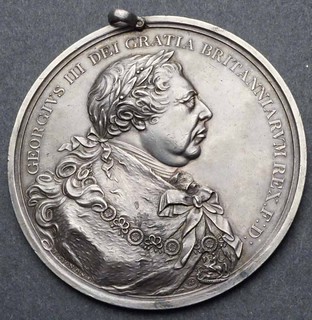
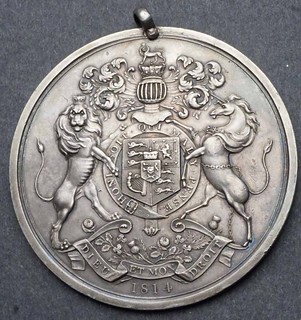
75mm, 124. 7 grams. This medal was designed to be awarded to the chiefs of those First Nations — mostly from the American side of a border that, to them, had little meaning — who fought with the British during the war of 1812. The obverse features the laureate bust of George III, right, draped in an ermine mantle, secured in front with a large ribboned bow, wearing the collar and jewel of St. George. Legend is : GEORGIVS III DEI GRATIA BRITANNIARUM REX. F. D. The reverse features the Royal Arms, with the date 1814 beneath. The medal is officially pierced, with a silver loop, for suspension. This is a very nice example. The edges and rims are sharp and free of nicks. There are only very light traces of wear in the fields, otherwise like new, with an attractive light grey even toning.
To read the complete lot description, see:
George
III Large Silver Peace or "Indian Chief" Medal 1814 — Very Nice Example
(http://www.swappy.com/en/9312-coins-paper-money/9859-other-coins-paper-money/p331288-george-iii-large-silver-peace-or-indian-chief-medal-1814-very-nice-example)
Lot 12: 1872 Dominion of Canada Chiefs Medal
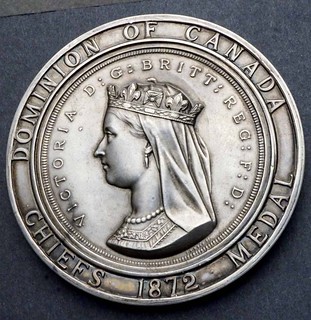
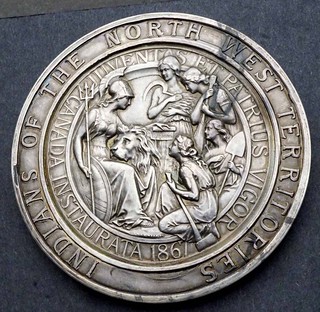
Dominion of Canada 1872 Chiefs Medal - Indians of the North West Territories - 93 mm, 418. 9 grams; 7 mm in thickness, not the 10 mm as has been reported. One of only 25 pieces commissioned to be produced by Robert Hendry, silversmith of Montreal, as replacements for the inferior stock medals originally presented to the chiefs of Treaties I (Anishinaabeg) and II (Muskego). Though the medals are marked "Indians of the North West Territories", on the reverse outer ring, these peoples are actually in what is now southern Manitoba.
The medals are impressive for their size; however, they are silver plated copper electrotypes, with an extra ring added to the basic 1867 Confederation medals. The obverse outer ring reads "Dominion of Canada Chiefs Medal 1872 " They were also not well received, as the silver plating easily peeled off, and were themselves replaced the following year, with a newly designed silver medal. With a production of only 25 examples, they are clearly very rare. On the other hand, there was no reason for any to have been melted down. Still, we can find no example of any recent sale. This is most likely the smallest production of all such "Indian Chief" presentation medals issued in North America.
To read the complete lot description, see:
Dominion of Canada 1872
Chiefs Medal - One of only 25 Produced!
(http://www.swappy.com/en/9312-coins-paper-money/9859-other-coins-paper-money/p331289-dominion-of-canada-1872-chiefs-medal-one-of-only-25-produced)
Lot 43: Courteau Canadian Token Monographs
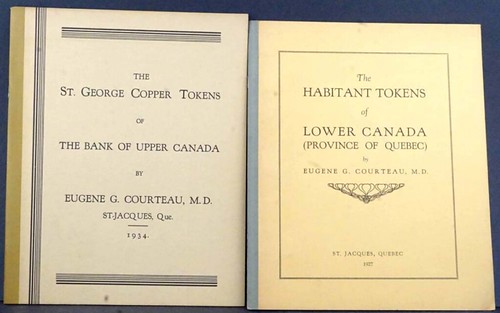
By Eugene G. Courteau, M. D. , 1910 - 1934. All self-published, at St. Jacques, Que. Identical measurements: 200 x 245 mm. Bound in boards, with differently coloured taped edges. 1) The COINS AND TOKENS of NOVA SCOTIA 1910. Seven Plates and 30 pages. Considerable internal annotation. 2) This one is bilingual. MONNAIES DE CUIVRE Emises par LA BANQUE DE MONTREAL - The COPPER TOKENS of THE BANK OF MONTREAL 1919. 25 pages, illustrations in the text, one page with two photos of the bank. Clean and solid, without any annotations. 3) The HABITANT TOKENS of LOWER CANADA (PROVINCE OF QUEBEC) 1927. Signed on top of the inside front cover : Hommage de l'auteur, Eug. G. Courteau. 24 pages, illustrations in the text. Clean, bright, like new. 4) The ST. GEORGE COPPER TOKENS of THE BANK OF UPPER CANADA 1934. 32 pages, with two illustrations in the text. One small faint pencil annotation on the back cover : 2525 underlined. Otherwise, clean and nice. One upper corner fold on the cover.
There are several lots of numismatic literature in the sale. -Editor
To read the complete lot description, see:
Four Matching
Original Volumes on Canadian Tokens by E. G. Courteau - Rare.
(http://www.swappy.com/en/9312-coins-paper-money/9859-other-coins-paper-money/p331321-four-matching-original-volumes-on-canadian-tokens-by-e-g-courteau-rare)
Lot 190: 1837 Lower Canada Merchant Scrip
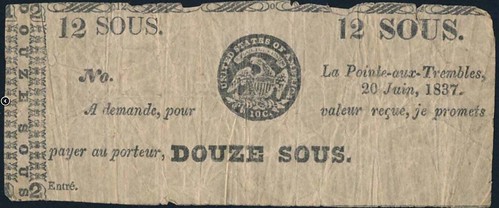
Merchant Scrip Lower Canada 1837 12 sous Unnumbered, unnamed, unlisted remainder Issued at La Pointe-aux-Trembles June 20, 1837. Not listed in Graham. 38 x 95 mm.
There are several lots of scrip with images of U.S. and world coins. -Editor
To read the complete lot description, see:
Merchant Scrip
Lower Canada 1837 12 sous Unnumbered, unnamed, unlisted
(http://www.swappy.com/en/9312-coins-paper-money/9859-other-coins-paper-money/p331463-merchant-scrip-lower-canada-1837-12-sous-unnumbered-unnamed-unlisted)
Lot 194: Correspondence 1894 - 1896
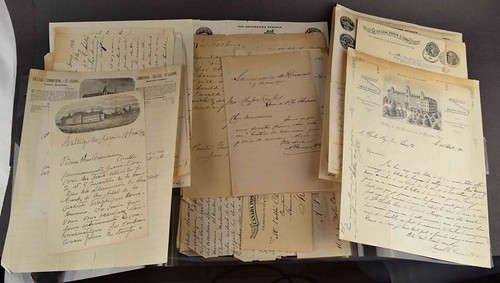
Correspondence 1894 - 1896 to Abée Charles Jos. Roy, Curator of the Musée Numismatique de la Séminaire de Sherbrooke. We will begin this section of our auction with a lot of most interesting documents dated from 1893 - 1896, the personal correspondence of the Abbé Charles J. Roy, Curator of the Musée Numismatique or Musée de Monnaie of the Séminaire St. Charles Borromé de Sherbrooke. While we have not been able to properly research this little treasure trove, a quick examination shows this as a fascinating documentation of the foundation and building of the museum. Much attention is paid to the acquisition from other institutions of examples of their internal Bank issues, which are exactly the notes in the lots that follow. This also aids us in approximately dating these notes. There is considerable correspondence from F. R. E. Campeau, F. X. Paquet, Ludger Gravel, J. O Marchand. , E. A. Cardinal, as well as letters from the Library of Parliament, Inland Revenue (the forerunner of Revenue Canada), postcards, etc. , Unsorted and unorganized. as is.
The sale includes interesting archival material as well. Could be a trove for researchers. -Editor
To read the complete lot description, see:
Correspondence
1894 - 1896 to Abée Charles Jos. Roy, Curator of the Musée
(http://www.swappy.com/en/9312-coins-paper-money/9859-other-coins-paper-money/p331467-correspondence-1894-1896-to-abee-charles-jos-roy-curator-of-the-musee)
Lot 197: La Banque du Seminaire St. Charles Borromé One Dollar
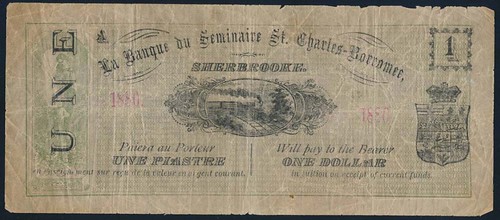
Possibly the oldest of these notes, is a $1, with a central vignette of a train. Bilingual, there is a "1880" in red, to left and right of the vignette. We presume this to be a date, rather than a serial number. This is the one and only example of this series among the collection of the Seminary.
A fascinating collection. Great opportunity for the right collector. -Editor
To read the complete lot description, see:
La
Banque du Seminaire St. Charles Borromé, Sherbrooke,One Dollar / Une Piastre
(http://www.swappy.com/en/9312-coins-paper-money/9859-other-coins-paper-money/p331470-la-banque-du-seminaire-st-charles-borrome-sherbrooke-one-dollar-une-piastre)

NUMISMATIC NUGGETS: SEPTEMBER 29, 2019
Here's a selection of interesting or unusual items I came across in the marketplace this week. Tell us what you think of some of these. -Editor
1537 Silver Medal of Karl V
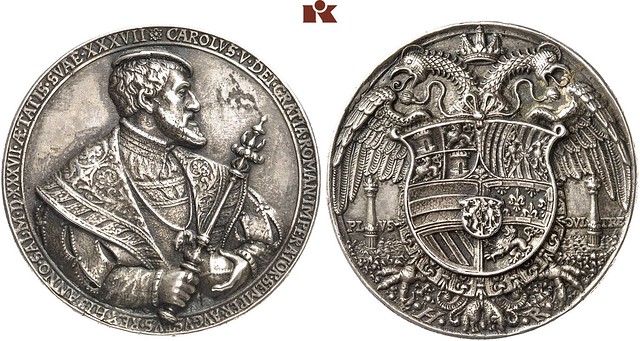
Silver medal 1537, after H. Reinhart. Ghosted Breast Picture r. with beret, robed cloak and the chain of the Order of the Golden Fleece, in the right scepter, in the left imperial apple // crowned double-headed eagle, on the chest four-bladed shield with center shield, surrounded by the chain of the Order of the Golden Fleece, to the sides ever a crowned pillar. 65.16 mm; 85.10 g. Habich II, 1, 1926; Coll. Lanna 598; Bernhart 93.
Contemporary font. Fields chiselled, very beautiful-exquisite
From the upcoming Künker sale. Google-translated text above. An amazingly elaborate medal. -Editor
To read the complete lot description, see:
Karl V., 1519-1558. Silbergußmedaille 1537, Habich II, 1, 1926; Slg. La
(https://www.kuenker.de/en/auktionen/stueck/230242)
1770 Royal Academy Prize Medal
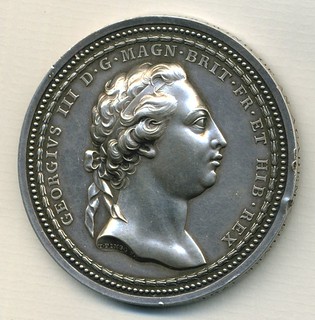
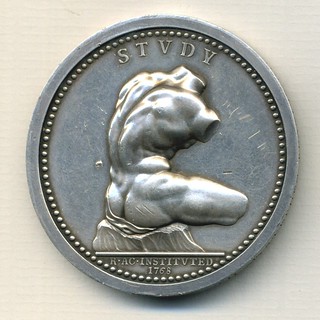
Royal Academy Prize Medal, silver prize, 1770, by T. Pingo, laureate bust of George III right within border of leaves and pellets, GEORGIUS III D. G. MAGN. BRIT. FR. ET. HIB. REX, rev. a representation of the Torso Belvedere by Cipriani within a beaded circle, STUDY/ R. AC. INSTITUTED/ 1768, edge engraved, To Mr Stephen Francis Rigaud For A Drawing Of An Academy Figure, 1794, 55 mm (BHM 133), contained in original shagreen case. Two edge knocks on the obverse and slightly rubbed on the high points, otherwise nearly extremely fine and extremely rare. £1450.00 The Royal Academy was founded in London in 1768 under the patronage of George III.
Stephen Francis Dutilh Rigaud (1777-1861). Painter. Son of John Francis Rigaud. Admitted to the Royal Academy in 1792.
From the stock of dealer Timothy Millet. -Editor
To read the complete item description, see:
Royal Academy Prize Medal,
(https://www.historicmedals.com/viewItem.php?no=3544&b=1&img=B)
1792 Barbados Copper Penny Token
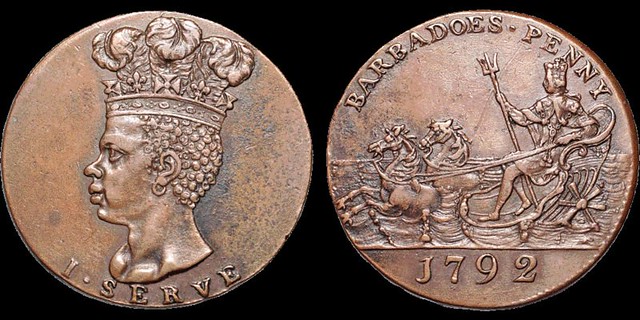
BARBADOS (WEST INDIES). Copper penny token. 13.16 gm. 30 mm. 1792. Head left wearing a coronet with a plume of three feathers / George III as Neptune seated in a chariot, being pulled left by two hippocampi; BARBADOES • PENNY 1792 around. Pridmore 15. KM TN 10. Spink (Colonial) Tn 10. Extremely Fine; depression across trident on reverse that was in flan before the piece was struck.
Made by John Milton in July 1792. In 1789 Milton became assistant engraver at the Royal Mint. These private issue tokens were made for Sir Philip Gibbs, a planter. Interestingly, this was soon after the first issues of the provincial token coinage series that Dalton and Hamer catalogued in the early 20th century. Zeitgeist....
From Davissons upcoming E-Auction 32. -Editor
To read the complete lot description, see:
E-Auction 32 Lot 147 (https://davcoin.com/lot/e-auction-32-lot-147)
1899 Barber Dime
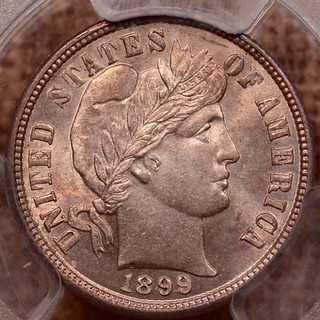
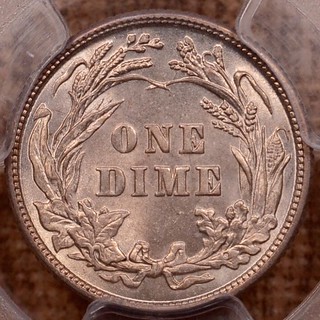
A nice affordable Barber dime from the site of David Khan. -Editor
To read the complete item description, see:
1899 Barber Dime PCGS MS64+
(https://www.davidkahnrarecoins.com/1899-10c-barber-dime-pcgs-ms64-19188352.html)
1901 Yale Bicentennial Medal
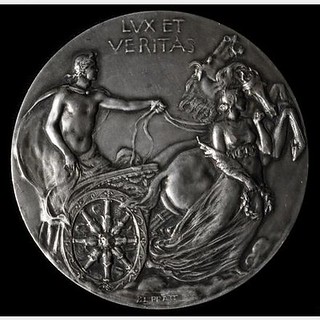
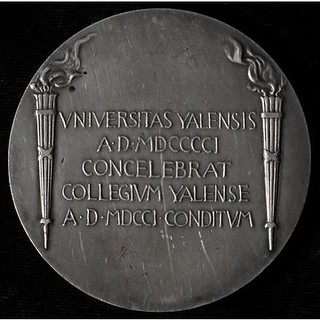
Sterling Silver Table Medal with obverse depicting Truth guiding Apollo's chariot. At top, LVX ET / VERITAS; signed at bottom, B L PRATT. The reverse bears five lines of inscription flanked by burning torches, VNIVERSITAS YALENSIS / A D MDCCCCI / CONCELEBRAT / COLLEGIVM YALENSE / A D MDCCI CONDITVM. The edge is hallmarked TIFFANY & CO. Ref: Marqusee 325. 2 3/4" diam. 5.625 ozt. Some wear. Bela Lyon Pratt was himself a graduate of Yale and was commissioned in 1899 by Professors Weir and Niemeyer to design this medal for the upcoming 200th anniversary of Yale College.
I'd never seen this one before. By coin designer Bela Lyon Pratt. -Editor
To read the complete lot description, see:
1901 SILVER
MEDAL BY TIFFANY FOR THE BICENTENNIAL OF YALE, DESIGNED BY BELA LYON PRATT (MA/ME/CT, 1867-1917)
(https://live.thomastonauction.com/lots/view/1-294YJJ/1901-silver-medal-by-tiffany-for-the-bicentennial-of-yale-designed-by-bela-lyon-pratt-mamect-1867-1917)
Ingle System Token Dispenser Register
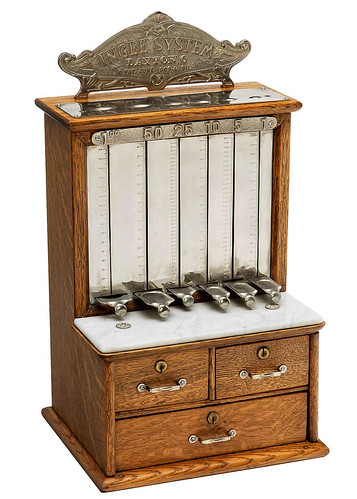 Description: Ingle System Token Dispenser Register, 1909 onwards
Description: Ingle System Token Dispenser Register, 1909 onwards
Dayton, Ohio. American payment system, companies used the token to pay their employees, thus ensuring their loyalty to the company stores. 6 coin chutes, marble tray, oak case
with 3 cash drawers, original top sign, overall height 22 ½ in., with key and 12 Ingle System tokens in various values.
How this ended up in a German auction is a mystery, but it looks to be in great condition and a wonderful opportunity for a token collector. -Editor
To read the complete lot description, see:
Lot 296: Ingle System Token Dispenser Register, 1909 onwards
(https://www.invaluable.com/auction-lot/ingle-system-token-dispenser-register-1909-onwar-296-c-4de4c58938)
Helen Hayes' Circus Saints and Sinners Medal
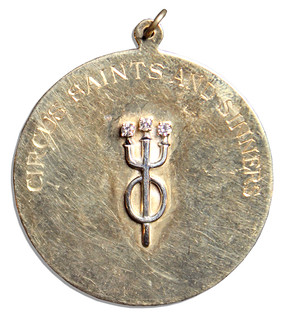
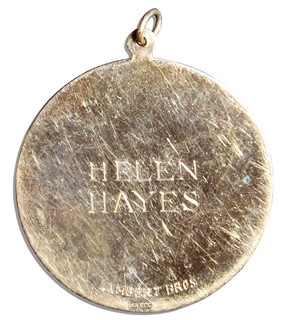
Helen Hayes' ''Circus Saints and Sinners'' gold medal adorned with a triad of diamonds. Hayes counted this award along with her Emmy, Grammy, Oscar and Tony, one of just eleven people ever to win all four. Hayes was also the recipient of the National Medal of Arts and Presidential Medal of Freedom. The Circus Saints and Sinners organization in Pittsburgh, PA began as a retirement fund for circus performers. It segued into broader philanthropic endeavors as the circus diminished when television took center stage for entertainment. 14k gold medallion features the organization's logo dotted with a trinity of round brilliant cut diamonds, each measuring approximately .03 carat. Engraved name ''CIRCUS SAINTS AND SINNERS'' arcs across the top. Reverse is engraved ''HELEN / HAYES / Lambert Bros.'' Top center features a loop for suspending from a chain. Medal measures 1.5'' in diameter. Faint scratching to reverse, else near fine. From the Helen Hayes estate.
I'd never heard of this organization before. Interesting item with a connection to my hometown - Pittsburgh. -Editor
To read the complete item description, see:
HELEN HAYES' MEDAL, MADE OF DIAMONDS & 14K GOLD
(https://natedsanders.com/Helen_Hayes__Medal__Made_of_Diamonds___14k_Gold-ITEM49385.aspx)
1930 Uruguay 1 Peso Commemorative Banknote
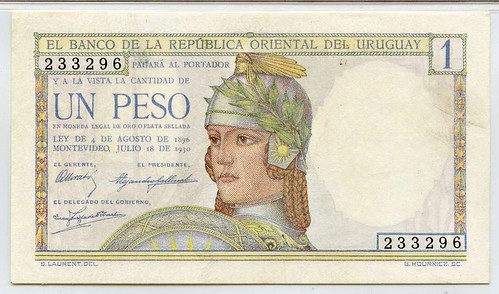
We are thrilled to offer an iconic note of South America and one of the earliest examples of a commemorative banknote in history. Various nations and kingdoms have used coins to commemorate important events since at least the 17th century, but commemorative banknotes are a relatively new phenomenon. This 1 Peso note from Uruguay was issued to commemorate 100 years of independence of the nation. It is dated July 18th, 1930, the date the Uruguayan constitution was adopted in 1830. For this special milestone, the nation decided to issue a three-note set (1, 5, 10 Pesos) which stood alone from their circulating notes at the time.
They enlisted the Bank of France and their distinct design style to create a beautiful note, with a helmeted woman on the obverse and a maritime scene on the reverse. The words “Centenario de 1830” feature prominently along the top. While it is not known how many of these notes were issued, they are very scarce today. When they do show up, they are usually heavily circulated. Our piece, graded a problem-free PMG XF40 shows little in the way of actual circulation, and the grade is most likely down to how this note has been stored over the years. PMG has graded only nine examples of this note.
From the site of David Lawrence Rare Coins. -Editor
To read the complete lot description, see:
Uruguay: 1930 1 Peso PMG 40 XF (P-17a) (https://www.davidlawrence.com/rare-coin/1302103)
1943 British Linen Bank £100 Banknote
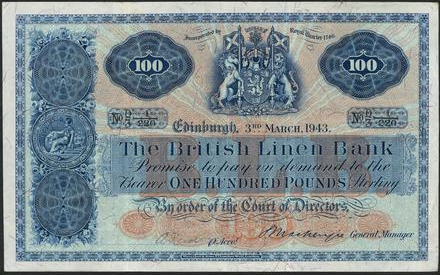
British Linen Bank, £100, 3 March 1943, serial number Q/3 1/220, blue and pale red, red sunburst pattern art centre, arms top centre, Britannia at left, manuscript signature low left, printed signature of Mackenzie low right, reverse blue, Britannia at centre, value at left and right (PMS BL69b, Banknote Yearbook SC243b), last date and prefix for type, an original attractive extremely fine and rare
From the upcoming October 10, 2019 Spink sale of the A.J. Simms Collection. -Editor
To read the complete lot description, see:
BRITISH LINEN BANK, £100, 3 MARCH 1943,
SERIAL NUMBER Q/3 1/220, (PMS BL69B, BANKNOTE YEARBOOK...
(https://live.spink.com/lots/view/4-4UVQY/british-linen-bank-100-3-march-1943-serial-number-q3-1220-pms-bl69b-banknote-yearbook)

ANGLO-SAXON COIN HOARD FOUND IN SUFFOLK
A hoard of Anglo-Saxon silver coins has been uncovered in Suffolk. Found via The Explorator newsletter. -Editor
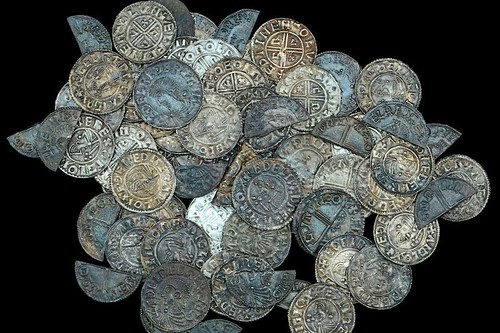
A builder is celebrating after finding a huge haul of 1,000-year-old silver coins worth £50,000 - including one from Lincolnshire which experts have never seen before.
Don Crawley, 50, was searching for buried treasure in farmland using his metal detector when he discovered the haul.
The 99 silver coins, which include 81 pennies and 18 cut halfpennies, date back to Anglo Saxon times and the reign of King Ethelred II from 978-1016AD.
Among the haul was one coin from Lincolnshire, which is marked as being from Lude - the Latin name for Louth - despite the town being more than 100 miles away.
It is believed at the time the coin was created, there were a number of mints across the country - meaning Louth had its own mint, which produced its own currency. The coin is the first example of its kind ever seen by experts.
The discovery was made on farmland in Suffolk and research has established that the site used to be the grounds of a long-forgotten Saxon church.
The coins have been examined by the British Museum and returned to Don as 'finders keepers'.
He has been told he is free to sell the hoard and it has been given a pre-sale estimate of £50,000 with London auctioneers Dix Noonan Webb.
He will split the proceeds with the land owner on a 50/50 basis.
To read the complete article, see:
Metal detectorist finds unique Anglo-Saxon coin from Lincolnshire in
£50,000 haul (https://www.lincolnshirelive.co.uk/news/uk-world-news/metal-detectorist-finds-unique-anglo-3354432)

MINE OF THE COMMANDER OF THE FAITHFUL
An important Islamic coin is coming up for sale in the October 24, 2019 Morton & Eden sale. Here's the lot description. -Editor
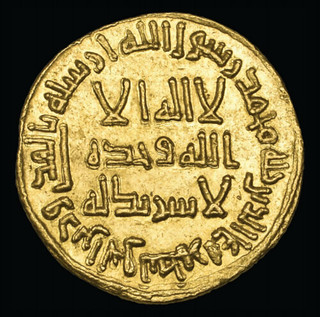
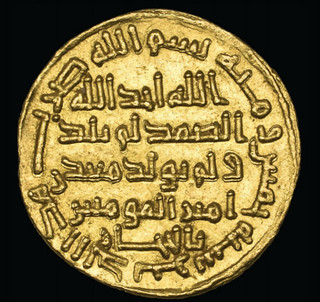
UMAYYAD, TEMP. HISHAM (105-125h)
Dinar, Ma'din Amir al-Mu'minin bi'l-Hijaz 105h
Reverse: In field: Allah ahad Allah | al-samad lam yalid | wa lam yulad Ma'din | Amir al-Mu'minin | bi'l-Hijaz Weight: 4.27g References: Fahmy 128, same dies; Bernardi 48Ed; Walker ANS.16 = Miles, RIC 66
Good extremely fine, extremely rare and a historically important coin
£1,400,000-1,600,000
Ex Baldwin's Islamic Coin Auction 19, 'Classical Rarities of Islamic Coinage,' 25 April 2012, lot 17.
EXTREMELY RARE AND OF GREAT HISTORICAL INTEREST, dinars from the 'Mine of the Commander of the Faithful in the Hijaz' have the distinction of being the first Islamic coins to mention a location within the present Kingdom of Saudi Arabia. The inscription which makes this coin so special is not difficult to translate: Ma'din Amir al-Mu'minin bi'l-Hijaz simply means 'Mine of the Commander of the Faithful, in the Hijaz.' But while scholars continue to study its precise meaning and significance, there are strong grounds for believing that the gold used in their manufacture came from a mine located between the Holy Cities of Makka and al-Madina, which was itself owned not only by several caliphs but which had been given to another former owner by the Prophet himself.
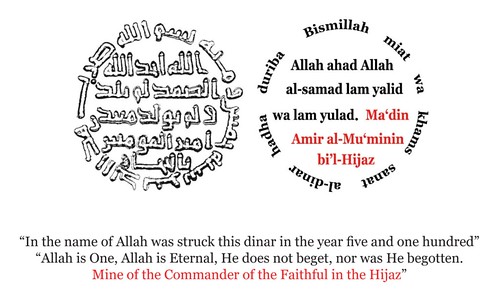
The meaning of Ma'din in this context remains the subject of scholarly debate, because it can be used figuratively (much as one can describe someone as 'a mine of information' in English) as well as literally. But there are good reasons to accept that Ma'din refers to a place from which ores or metals are mined and recovered. This is certainly how the word is used on Abbasid silver dirhams struck less than a century later, on which the mint-name in the margin is given as Ma'din al-Shash or Ma'din Bajunays, meaning 'the mine at Tashkent' and 'the mine at Bajunays' respectively. Legends on other Umayyad coins are, without exception, either religious (verses from the Qur'an) or practical (information about where, and on some copper coins by whom, they were struck), and it is difficult to see why we should expect Ma'din Amir al-Mu'minin to be anything different.
Amir al-Mu'minin, meaning 'Commander of the Faithful,' is a title which can only refer to the caliph himself. However, two caliphs held office during the year 105h, when Hisham (105-125h) succeeded Yazid II (101-105h). Is it possible to say which of these two caliphs amir al-mu'minin denotes? Yazid II appears to have been in Syria throughout this year, and probably died in Damascus (al-Tabari 1463). Hisham was also in Syria when he became caliph but must have travelled to the Holy Places soon afterwards, since we hear of him delivering a funeral speech at the cemetery near al-Madina later in the year 105h (al-Tabari 1472), and he remained in the region in 106h also. Since Hisham was in the Hijaz in the year when these remarkable coins were issued, while Yazid was not, we are probably justified in following Miles in believing that Hisham is the caliph mentioned here (Miles 1972, p.266).
Remarkably, Miles was able to identify a very plausible candidate for exactly where the 'mine of the Commander of the Faithful in the Hijaz' may have been located. According to Miles, who built on earlier research by Paul Casanova, the caliph 'Umar (99-101h) purchased a mine called the Ma'din Bani Sulaym, located between Medina and Mecca. This mine had previously been held by the sons of Bilal al-Harith, who had been granted it the Prophet himself. According to Miles, 'Casanova quite reasonably argued that the mine became known as the Mine of the Amir al-Mu'minin and that Yazid II inherited it from his predecessor; hence the phrase amir al-mu'minin on the issue of 105 H' (Miles 1972, p.266). Given that Miles and Casanova had no difficulty accepting that Yazid could inherit the mine from 'Umar, there seems no reason to doubt that Hisham could have inherited it from Yazid in his turn. If so, then the mine mentioned on this coin not only belonged at least three caliphs, but had been bestowed on a previous owner by the Prophet himself.
Thus the Ma'din amir al-mu'minin inscription seems best understood as indicating the origin of the gold used to strike these rare coins. No other mediaeval Islamic gold coin carries this information. Mediaeval Islamic gold coins often include the place of manufacture in the marginal legend with the date, but the actual source of the gold is not indicated. Why was it felt necessary to include this information on these dinars? One possibility is that there may have been an administrative reason: these coins were produced from gold which came from the caliph's private resources, rather than state revenues, and were marked as such for accounting purposes. But there are also grounds for believing that these coins were not only made from gold mined in the Hijaz, but were actually struck there too.
The dies used on all Ma'din dinars were prepared in Damascus, and we know that the obverse die used to strike this very piece was also used to manufacture standard Umayyad dinars dated 105h. But travelling mints were not uncommon in the ancient world, and the simple tools needed to strike coins by hand were eminently portable. Workers and equipment from Damascus could have accompanied Hisham on his journey from Syria to the Hijaz in 105h, and a major pilgrim highway went right past the Ma'din Bani Sulaym - an inscription recording the rebuilding of this road in 304h was found among old mine-workings (Miles 1950). Thus the caliph might easily have taken the opportunity to visit his mine en route and strike a small quantity of special gold dinars bearing the Ma'din Amir al-Mu'minin bi'l-Hijaz legend. It is also possible that the raw gold was sent back to Damascus and the coins struck there, but this is harder to reconcile with the caliph's movements given that Hisham was still in Arabia in the year 106h and had not yet returned to Syria. Thus in this case it seems preferable to assume that these rare and fascinating coins were actually struck in the Hijaz region from gold mined there, making them the earliest Islamic gold coins to have been struck in present-day Saudi Arabia.
Specialist References:
Miles 1950 Miles, G.C., Rare Islamic Coins, ANS Numismatic Notes and Monographs 118, New York, 1950
Miles 1972 Miles, G.C., 'A Unique Umayyad dinar of 91h,' Revue Numismatique, 6e Serie, Tome 14 (1972), pp. 264-268
To read the complete catalog, see:
Important Coins of the Islamic World
(https://www.mortonandeden.com/wp-content/uploads/2019/09/103_web.pdf)
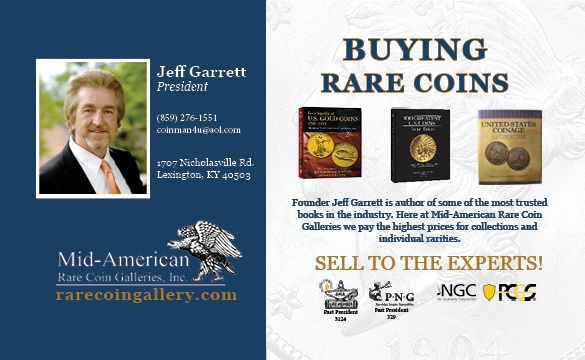
LOUIS VIII OF HESSE-DARMSTADT HUNTING MEDALS
An article on the Künker web site highlights an interesting group of hunting-related medals in the firm's upcoming sale. Here's an excerpt - see more great medals in the full article online. -Editor
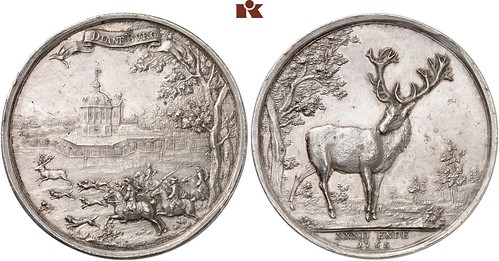
He was an enlightened Landgrave and of influence far beyond his realm: Louis VIII of Hesse-Darmstadt was born on 5 April 1691, as the eldest son of Landgrave Ernest Louis. He pursued his career at the service of the House of Habsburg as one of their closest confidantes and collaborators. He was an enlightened Landgrave and of influence far beyond his realm: Louis VIII of Hesse-Darmstadt was born on 5 April 1691, as the eldest son of Landgrave Ernest Louis. He pursued his career at the service of the House of Habsburg as one of their closest confidantes and collaborators.
When he was still a crown prince, at the age of 31, Louis VIII entered the imperial military in 1722. This would be the beginning of a long-year, loyal collaboration with the House of Habsburg. In 1735, Emperor Charles VI named him commander of his cavalry. In this position, Louis VIII defended Maria Theresa's rights in the First Silesian War and the War of the Austrian Succession. The Austrian ruling couple appreciated Louis. In 1745, Francis I of Lorraine, Maria Theresa's husband, accorded him the right to present to him the emperor's election decree. The medal offered at Künker's on 9 October 2019, showing the officer on horseback in commander's pose, was likely made to commemorate this honor.
Louis VIII occupied the highest commanding posts in the Empress' and the Empire's army. During the Seven Years' War, he served at the rank of General Field Marshal as Commander-in-Chief of the imperial forces – which made him the direct opponent of Frederick II of Prussia. A great career, you see. And Louis VIII also achieved a lot for his own reign. He added the County of Hanau-Lichtenberg to his territory, as well as large parts of the Babenhausen district. He had numerous social institutions built and was considered sponsor of the arts – he was even active as a composer himself. How fitting then that he died in his box seat during an opera on 17 October 1768. Nevertheless, whenever you read something about this ruler, the focus is on his love of hunting, as if that had been his only hobby
To read the complete article, see:
The hunting pleasures of the Landgrave of Hesse-Darmstadt
(https://www.kuenker.de/en/information/presseinformationen/aktuelle-mitteilungen/251)
THE BOOK BAZARRE
MOST VALUABLE TREASURE TROVES EVER FOUND
The Interesting Engineering site rercently published an article on "10 of the Most Valuable Treasure Troves Ever Found" by amateurs wielding metal detectors. Many of these hoards include or consist entirely of coins. -Editor
1. Staffordshire Hoard - 2009 | Value: $4.1 Million On July 5, 2009, Terry Herbert, an amateur treasure hunter, was searching a newly-plowed farm field near Hammerwich, Staffordshire, England when his metal detector pinged. With the permission of the landowner, Fred Johnson, over five days of digging, 3,500 objects were pulled from the ground.
They were part of what came to be called the Staffordshire Hoard. It is comprised solely of military objects, with no vessels or eating utensils or jewelry. It included over 11 pounds (5.1 kg) of gold, 3 pounds (1.4 kg) of silver and semi-precious garnets. The garnets would have come from as far away as Sri Lanka or Afghanistan.
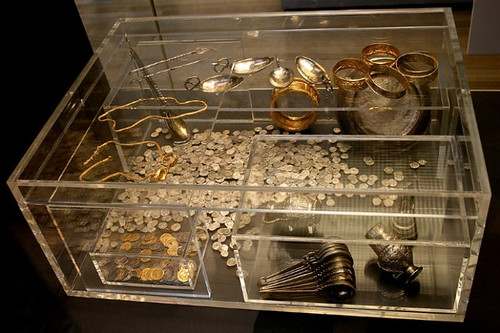
4. Hoxne Hoard - 1992 | Value: $3.8 Million On November 16, 1992, tenant farmer Peter Whatling had lost a hammer in a farm field just southwest of the village of Hoxne in Suffolk, England. The tenant asked his friend, Eric Lawes, to use his metal detector to find the hammer.
What Lawes found instead were silver spoons, gold jewelry, and gold and silver coins. After alerting authorities, a team of archaeologists was dispatched to the site, and they excavated it in a day.
What they unearthed was the largest hoard of late Roman gold and silver ever discovered in Britain. The Hoxne Hoard is also the largest collection of fourth and fifth-century coins found anywhere in the Roman Empire.
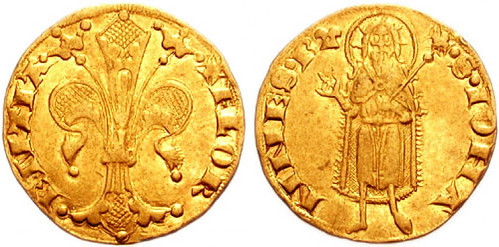
6. Sroda Treasure - 1885 - 1888 | Value: $120 Million On June 8, 1885, workers were demolishing an old building in the Polish town of Sroda Slaska when they found a vase. In it were over 3,000 silver coins dating to the 14th century.
When demolition work moved to a nearby building, silver coins and gold florin coins were found. Enterprising locals started scouring the municipal landfill where debris from the buildings had been taken. That's when things took an eye-popping turn.
Items found included a gold woman's crown that most likely belonged to the first wife of Emperor Charles IV, two 12th century gold pendants, two 13th century gold pendants, a medieval gold clasp containing precious stones, and a sapphire ring.
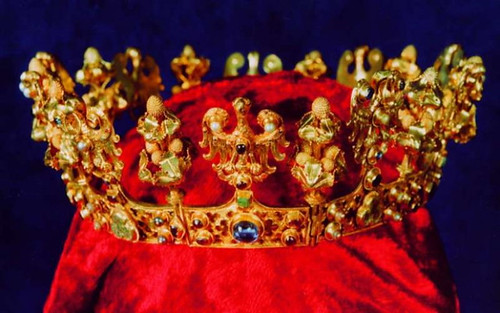
To read the complete article, see:
10 of the Most Valuable Treasure Troves Ever Found
(https://interestingengineering.com/10-of-the-most-valuable-treasure-troves-ever-found)

THE QUEEN'S STAMP COLLECTION
It's non-numismatic, but interesting nonetheless. The U.K. Cosmopolitan magazine recently ran a piece about Queen Elizabeth and her stamp collection. Here's an excerpt. See the complete article online for more. -Editor
While you and I are struggling to make enough money to do a weekly shop in M&S, Queen Elizabeth is apparently sitting on a cool £100million made entirely from her hobby... of stamp collecting.
The monarch, whose net-worth is around $530million according to Forbes, is apparently a proud owner of a huge stamp collection that's raking in the pounds. The Telegraph reports that it includes a Mauritian stamp valued at £2million, which was shown in a travelling exhibition to celebrate the Queen's Golden Jubilee in 2002.
In fact, according to royal expert Phil Dampier, the 93-year-old is so proud of her collection that she loves to show it off to visitors in Buckingham Palace.
“The Queen loves showing her stamp collection to visitors, say heads of state who stay at Buckingham Palace,” Dampier told Fabulous.
“It is one of her pride and joys, not only because she owns some of the world's most valuable stamps, but also because she has built on a family treasure and feels she has done her father and previous monarchs who owned it proud.”
The collection was originally started by Queen Victoria's second son, Prince Alfred in 1864, but has been passed down through members of the royal family.
To read the complete article, see:
The Queen's stamp-collection hobby has apparently earned her £100
million (https://www.cosmopolitan.com/uk/reports/a29120312/the-queen-stamp-collection-hobby-money/)
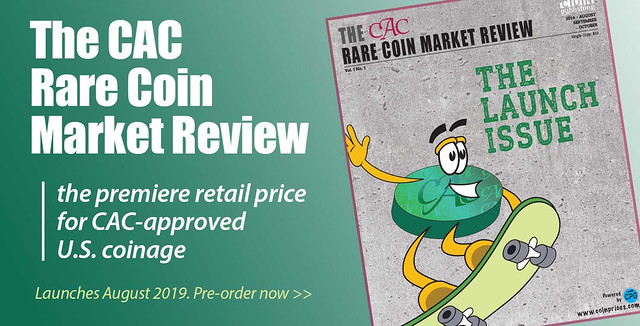
LOOSE CHANGE: SEPTEMBER 29, 2019
Here are some additional items in the media this week that may be of interest. -Editor
Spink Sells Inverted Jennys
Here's another stamp story in the news. -Editor
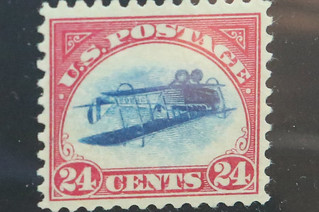 The 31-year-old son of billionaire “Bond King” Bill Gross has sold five rare postage stamps against his father's wishes — and bagged nearly $1.9 million in the
process.
The 31-year-old son of billionaire “Bond King” Bill Gross has sold five rare postage stamps against his father's wishes — and bagged nearly $1.9 million in the
process.
The final gavel price for the prized “Inverted Jenny” stamps, however, fell sorely short of the $3.4 million hoped for by Nick Gross, an LA-based rock drummer — and he might have his pop to blame for the missing $1.5 million, sources said.
“The low price could be a function of the dispute over ownership, over questions about title,” according to a source close to the situation.
A block of four of the prized “Inverted Jenny” stamps — named for a 1918 printing error that pictured a so-called Jenny biplane upside-down — ended up selling for $1.45 million.
The fifth stamp sold for $425,000, within the auction house's range of $250,000 to $675,000.
To read the complete article, see:
Rare stamps at center of 'Bond King' family feud sell for $1.9M
(https://nypost.com/2019/09/27/rare-stamps-at-center-of-bond-king-family-feud-sell-for-1-9m/)
Dr. Arnold Keller Biography
A great illustrated article in German on the life of author Dr. Arnold Keller has been published by Geldscheine Online. Here's the Google-translated introduction. -Editor
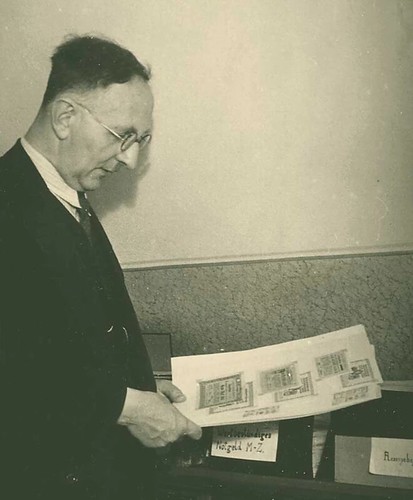 Dr. Arnold Keller - A collector's life
Dr. Arnold Keller - A collector's life
Much has already been written about the old master of paper money collecting in Germany, and his outstanding achievements have been acknowledged in many ways. Through his many years of diligent research Arnold Keller pioneered and created the conditions for the recognition of notaphilia as an independent branch of numismatic science. His extensive catalog still forms an important basis for collectors and researchers. With his many works he has left lasting traces and equipped and shaped generations of collectors with basic knowledge.
To read the complete article, see:
Dr. Arnold Keller – Ein Sammlerleben
(https://www.geldscheine-online.com/post/dr-arnold-keller-ein-sammlerleben)

FEATURED WEB PAGE: JEWISH UKRAINE NUMISMATICS
This week's Featured Web Page is about prominent Jewish figures and themes on coins and banknotes of Ukraine.Let's start not with a coin, but with a banknote that was released last in December 2017. This souvenir banknote of 100 karbovanets is a replica of the first Ukrainian banknote issued by the Central Rada a hundred years before. The author of the sketch is the famous artist Heorhii Narbut. The back of the Ukrainian banknote features an inscription in Yiddish—as in the original of 1917.
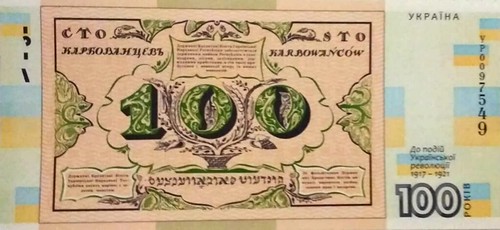
https://ukrainianjewishencounter.org/en/
prominent-jewish-figures-and-themes-on-coins-and-banknotes-of-ukraine/

